
THE MGA 1600, ‘DELUXE’ AND 1600 MARK II
Even from the outset, there were pleas from a number of factions for a bigger engine in the MGA. However, it took time for these requests to filter through the system, and even then they did not always receive a warm reception from senior BMC management. Gus Ehrman told the author that he almost lost count of the requests that fell on deaf ears, not only in powertrain terms but also for practical things such as stronger bumpers and over-riders, which would be less vulnerable to the prevailing American highstreet car-parking habits, and some of the creature comforts found in other cars. As Ehrman explained:
When the MGA came out, we said ‘Look, we have got to have a car with wind-up windows’ – to which the response was that a sports car did not need wind-up windows. Similarly, we were not satisfied with the 1498cc engine – we could usefully have had a 1900cc engine or something like that. Finally, after three years of pleading, we got the 1600! The continual problem was that BMC management would not listen to what we asked for. They would say things like ‘It’s such a limited market, it’s not worth the expense’ – but at the time, British sports cars had the market sewn up.
As we shall see in Chapter 9, there were thoughts of both a 1.7-litre and even a 2.2-litre MGA – but neither came close to production.

By the time that the MGA 1600 was on sale, the detachable side screens used sliding panels for improved convenience of use and visibility – still not quite the sophistication that would later be seen on the MGB just three years later.
AUTHOR’S COLLECTION

MGA 1600 blueprint.
BOB VITRIKAS

The facia of the MGA 1600.
AUTHOR’S COLLECTION
In the end, MG’s success in getting the BMC Board to sanction the creation of the Twin Cam, enlarged at a late stage to meet the competition demands of a 1.6-litre racing class, helped facilitate the creation of a version of the B-Series engine that shared the Twin Cam’s 1588cc capacity but with the conventional overhead valve train. The 1588cc B-Series engine capacity remained unique to the MGA; the Z-Magnette and mainstream BMC saloons generally retained the 1498cc capacity until the later change, coinciding with a major overhaul that brought in the larger capacity unit, covered later in this chapter (although BMC, being BMC, still kept the ‘1.5’ engines for some models until well into the following decade).

For the MGA 1600, BMC increased the capacity to 1588cc, matching that of the MGA Twin Cam, which remained in production. On the reverse of this image was a label with the words: ‘Confidential – not to be released before 31 July 1959. MGA 1600: the neat engine installation is clearly visible, as also are the heater and windscreen-washing equipment. Despite the compactness of the engine compartment, access for routine maintenance is extraordinarily good.’
AUTHOR’S COLLECTION

The MGA 1600 brought in front disc brakes, although they were sourced from Lockheed, rather than Dunlop, who supplied the four-wheel disc units of the MGA Twin Cam.
AUTHOR’S COLLECTION
PRX 14 – THE FIRST MGA 1600

Alec Rivers Fletcher and his wife Penny in PRX 14.
JEREMY RIVERS FLETCHER
The first MGA to be fitted for testing purposes with the new 1600 engine was the ‘show shop’ Glacier Blue MGA Coupé 1500, registered PRX 14 on 30 June 1958 (MGA Coupé chassis no. HMD 13-53352; engine no. 15GB-U-H/43971). Originally a 1500, the car appeared in this guise at the press launch of the MGA Twin Cam (see Chapter 6). Having been used for assessment of the 1588cc ohv unit, and occasionally loaned to the likes of Nancy Mitchell and Jack Sears, PRX 14 would later be fitted with an over-bored 1844cc engine prior to the launch of the MGB, again for testing purposes.

Mike Peters is the present owner of PRX 14 – the first MGA fitted with a 1600 engine – which was later acquired by Alec (A.F.) Rivers Fletcher, and repainted in his favourite Bugatti Blue with white roundels.
MIKE PETERS
A. F. Rivers-Fletcher later bought the car in 1979 and converted it for his own use, including having it repainted Bugatti Blue (a colour he used for all his race cars), using it at various hillclimbs and similar events during his period of ownership. He fitted it with an opening pop-up glass roof window, of a kind commonly fitted by aftermarket specialists (usually to family hatchbacks) in the 1980s, and had part of the rear parcel shelf cut away so that he could carry his film projection equipment that he often took with him to club events and lectures on his lifetime of motor-racing exploits.
More recently, PRX 14 was acquired by enthusiast Mike Peters, who entrusted it to James Horner to thoroughly but sensitively restore it; the work included removing the pop-up roof and making new microcell seats.
Meanwhile the last MGA 1500 came at chassis no. 68850 (the last 15GD engine was 7816); the very next number in the sequence (68851) marked the first of the new MGA 1600 models, with the ‘16GA’ 1588cc engine. This first car, destined for demonstration duties, happened to be a blue USspecification specimen, with a black interior and black hood, and was completed at the factory on 1 June 1959. Press cars with chassis numbers 69102 and 69103 followed the next day.

This North American (BMC Canada) PR image for the new MGA 1600 features the de rigueur wire wheels and white-wall tyres so often specified by customers.
AUTHOR’S COLLECTION
However, equally significantly, with the new model there was also a change of chassis number prefix system, with ‘GHN’ signifying a roadster (in place of the outgoing ‘HD’ code), and ‘GHD’ a coupé (instead of ‘HM’), with a fourth prefix letter ‘L’ exclusively for left-hand-drive models whether roadster or coupé.
As well as the fitment of front disc brakes (Lockheed rather than the Dunlop units of the Twin Cam), the new model had larger front side lamps with integral indicators, tail-lamps made up of separate indicators and combined tail/stop lamps, mounted on body-coloured plinths in approximately the same position as before, and on the roadsters, improved removable sliding-window side-screens. To make the new engine size clearer to casual kerb-side by-standers, neat ‘1600’ script badges were also added alongside the cowl vents and at the rear, all in the same location as the ‘Twin-Cam’ badges on that model.
Body numbers now came with a new ‘B’ prefix. Inside the Coupé cockpit, the spare wheel was moved back, so that it was now entirely contained within the boot compartment, and the rear window shelf became narrower. At the same time, the equivalent body and electrical changes were also introduced, as appropriate, on the MGA Twin Cam (chassis no. 2189 in May 1959 for the Twin Cam Coupé; no. 2193 for the Twin Cam Roadster in June).

The reverse of this photograph of 899 CFC makes reference to the MGA 1600 press date of 31 July 1959.
AUTHOR

New MGA ‘1600’ features more go... more stop In keeping with the traditional MG slogan ‘Safety Fast!’ the newest version of this popular sports car features a bigger capacity (1600cc) engine for vastly improved power and acceleration and a remarkably efficient brake system employing eleven inch discs at front and ten inch drum brakes at rear. Body styling is virtually unchanged except for slight modification at rear to accommodate an improved tail-light design. Sports Roadster and Coupé versions of this new model are available in a wide range of brilliant color finishes. Manufactured by the British Motor Corporation, the MGA 1600 is imported by Hambro Automotive Corporation of New York and sold throughout the United States by a network of over 600 dealers. Prices begin at $2,485 (POE West Coast).
FROM: HAMBRO AUTOMOTIVE CORPORATION, PUBLIC RELATIONS DEPARTMENT, 27 WEST 57TH STREET, NEW YORK 19, NY PL 9-3150

This side view of an MGA 1600 accompanied the Hambro press release. For some reason this particular car been fitted with MG Z Magnette hub-caps (with MG badge medallions).
AUTHOR
APPENDIX J
The 1958 FIA regulations, in particular ‘Appendix J’, Chapter I, Article 253, defined the engine capacity ranges for each of the race classes. When this included a category of 1.3 to 1.6 litres, it was obvious that an engine near the limit – say, 1599cc – would have advantages over a smaller unit – which of course highlighted the effective handicap that was faced by the original 1498cc B-Series of the early MGA. It was this factor which influenced the move to 1588cc for first the Twin Cam (from its outset), and then the regular ‘ohv’ model, hence the original ‘MGA 1600’. As we shall see in the motorsport chapter, the change on the MGA 1600 Mark II to 1622cc would pose a fresh challenge, potentially pitching the MGA straight into the 2-litre class. The RAC handled the MGA 1600’s certification (‘FIA Recognition No. 29 – dated 17 September 1959’) in readiness for the 1960 racing season – of which more later.
The MGA 1600 formally arrived in the market place on 31 July 1959; in June, as part of the run-up to this public announcement, BMC invited a small number of motoring correspondents to an entertaining drive in the Swiss Alps, the mountain driving intended to show off the benefits of the new disc brakes on the front wheels – Lockheed units instead of the all-round Dunlop disc brakes used for the MGA Twin Cam, which remained on sale. As BMC’s sportscar interests also extended to the Austin-Healey, the same group of journalists was also able to drive examples of the recently announced 3000.
As reported in a subsequent issue of Motorsport, the party of journalists were flown out to Lyon by a specially chartered Viscount jet airliner, to find upon their arrival a dozen shiny new French-registered BMC sports cars lined up – six Austin-Healeys and the same number of the improved MGA. The task then posed by their hosts was to drive 300 miles to Cap d’Antibes in time for dinner. The suggested route avoided the N7 Autoroute and took in Grenoble, Gap, Dignon and Grasse, but Michael Twite of Motorsport (in a red MGA) teamed up with Gregor Grant of Autosport (in a Healey) and opted for the N7.
After an enjoyable drive and evening meal, the group retired in anticipation of a second day described by Motorsport as a ‘gastronomic expedition’; two further days of fairly free motoring through towns and the open roads of Switzerland and France must have seemed like unbridled luxury to 1950s British journalists, but all good things come to an end, and in this case the cars were driven to Nice Airport, from where the various guests were to be flown back to England courtesy of Air France. Michael Twite concluded that despite having to tear themselves away from the joys of skiing and the Riviera, he and his colleagues had gained ‘a healthy respect for the latest versions of the MG and Austin-Healey’.
Another motoring correspondent on the trip was W.A. (Bill) McKenzie of The Daily Telegraph, whose write-up appeared in the paper on 31 July 1959, just as the car was launched to the public. McKenzie wrote that:
…the extra power makes the car more flexible in slow traffic and raises the whole performance. I found on a test in the French Alps that it could climb the gradients of mountain passes on third gear. But if second were used for the hairpin bends and a change-up made soon afterwards, every mile of a long alpine climb could be covered in one and a half minutes, at an average speed of 45mph [70km/h]. The steering is light but as direct as the sports-car driver asks for. This makes for utmost control at high speed on the most tortuous course.
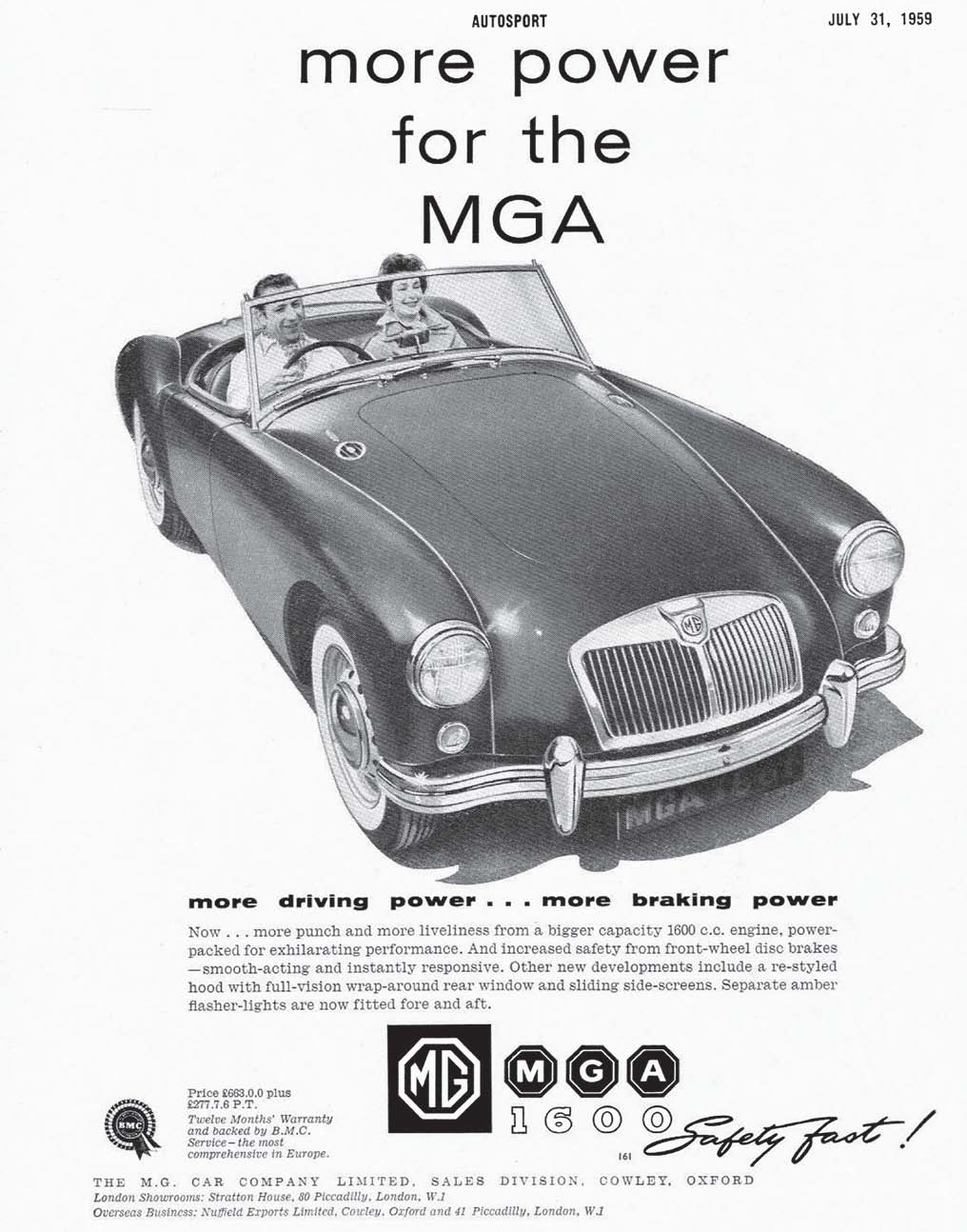
An advertisement for the MGA 1600 from the 31 July 1959 issue of Autosport.
AUTHOR’S COLLECTION

Motor, 19 April 1961.
AUTHOR’S COLLECTION
Obviously quoting from PR material, McKenzie added that the MGA had ‘earned nearly £21,500,000 in North American markets alone. The new MGA1600 is expected to do even better.’
Motor subjected the new MGA 1600 to a road test for their issue of 2 September 1959; their photographs were of SMO 907, and the test headline summarized the benefits of ‘extra acceleration and retardation for a popular sporting car’. The 1600 engine offered improved acceleration but not top speed, but at the same time the testers complemented MG on improved refinement: ‘Complete docility characterizes the enlarged engine, as witness our recording of 10mph, and it runs happily on ordinary premium grades of petrol without demanding 100 octane, but it does not feel to pull its full weight below 2,500rpm.’
The magazine concluded that:
With its share of the imperfections from which no car ever altogether escapes, this remains a very attractive and versatile sporting two-seater. Sturdy, well furnished and probably built with more thorough care than most of its contemporaries, it travels fast and is enjoyable to drive or ride in, yet can also serve as a reliable and weatherproof form of everyday transportation.
A week behind their rival, Autocar tested an Alamo Beige 1600 Roadster for their 9 October 1959 issue: slightly in contrast to their rivals, the testers commented that whilst the larger engine had improved performance, refinement had suffered (on their test car at least), noting that:
There was a tendency for the engine of the test car to become rough and to vibrate at about 5,000rpm, but if the throttle pedal were held down, this disappeared as the engine speed continued to mount. Members of staff with experience of the previous MGA feel the more powerful engine to be rather more noisy and harsh.
Autocar noted that the new sidescreens were an improvement over the earlier versions (a point on which few MGA owners would disagree!), although as the testing took place during fine weather, the testers admitted that they had not really had a chance to test the new set-up for leakages in wet weather. Although the largely unchanged gearbox and cockpit layout were generally praised, the MG tradition of having the horn button on the facia rather than in the centre of the steering wheel was deemed an inconvenient anachronism.
The magazine concluded that the larger-engined MGA’s ‘powerful, responsive engine, combined with a moderately heavy but low-slung chassis, adequate steering and superlative brakes, and without any little vices or unpredictable traits in behaviour, maintains the traditional high standards of performance and safety of the marque.’
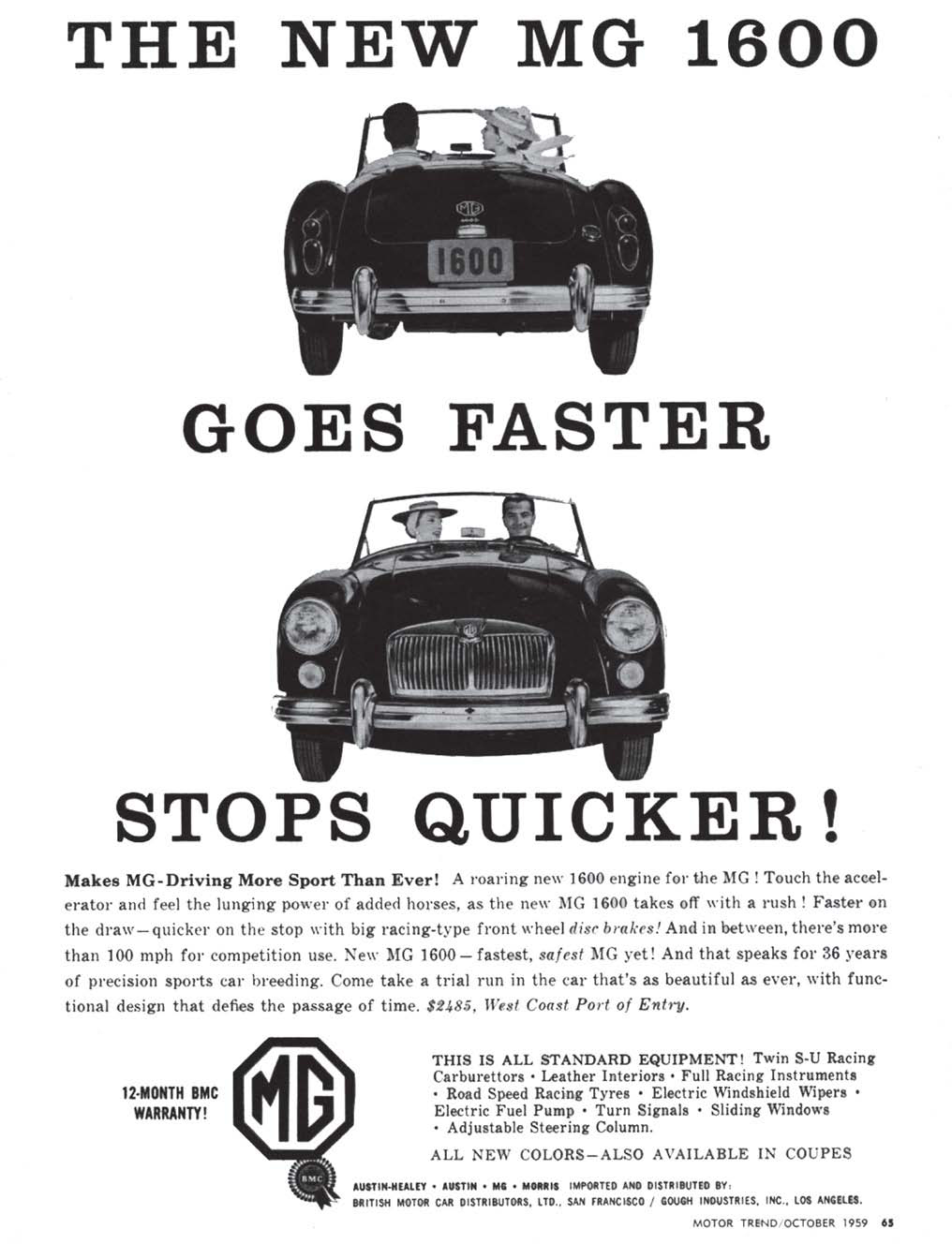
Motor Trend, October 1959.
AUTHOR’S COLLECTION
Meanwhile the Nuffield Organisation’s own internal publication, Nuffield Teamwork, declared that the MGA (in 1500 and Twin Cam guise) had already earned $60 million sales in the USA alone; clearly the MGA 1600 was expected to build on this.
For the home market, a new brochure H.6091 was produced, with a predominantly bright red cover and artwork of the ‘MGA 1600’ title above a left-hand-drive MGA Roadster and happy couple, the driver waving, and the ‘Safety Fast!’ logo off to one side. Inside, the brochure featured colour artwork of an MGA Coupé front on, which was clearly related to contemporary magazine advertising as well as another sideprofile image clearly based on the US press image used for the MGA Coupé. The text suggested, of the MGA 1600, that:
…it looks fast. And that’s how it goes. You would not expect less. Not from the new track-bred ‘MGA 1600’. Not from this proud descendant of the world’s most famous line of sports cars, embodying over thirty years’ experience of racing and high speed, record-breaking achievements.

The home-market brochure for the MGA 1600 (publication number H6091).
AUTHOR’S COLLECTION
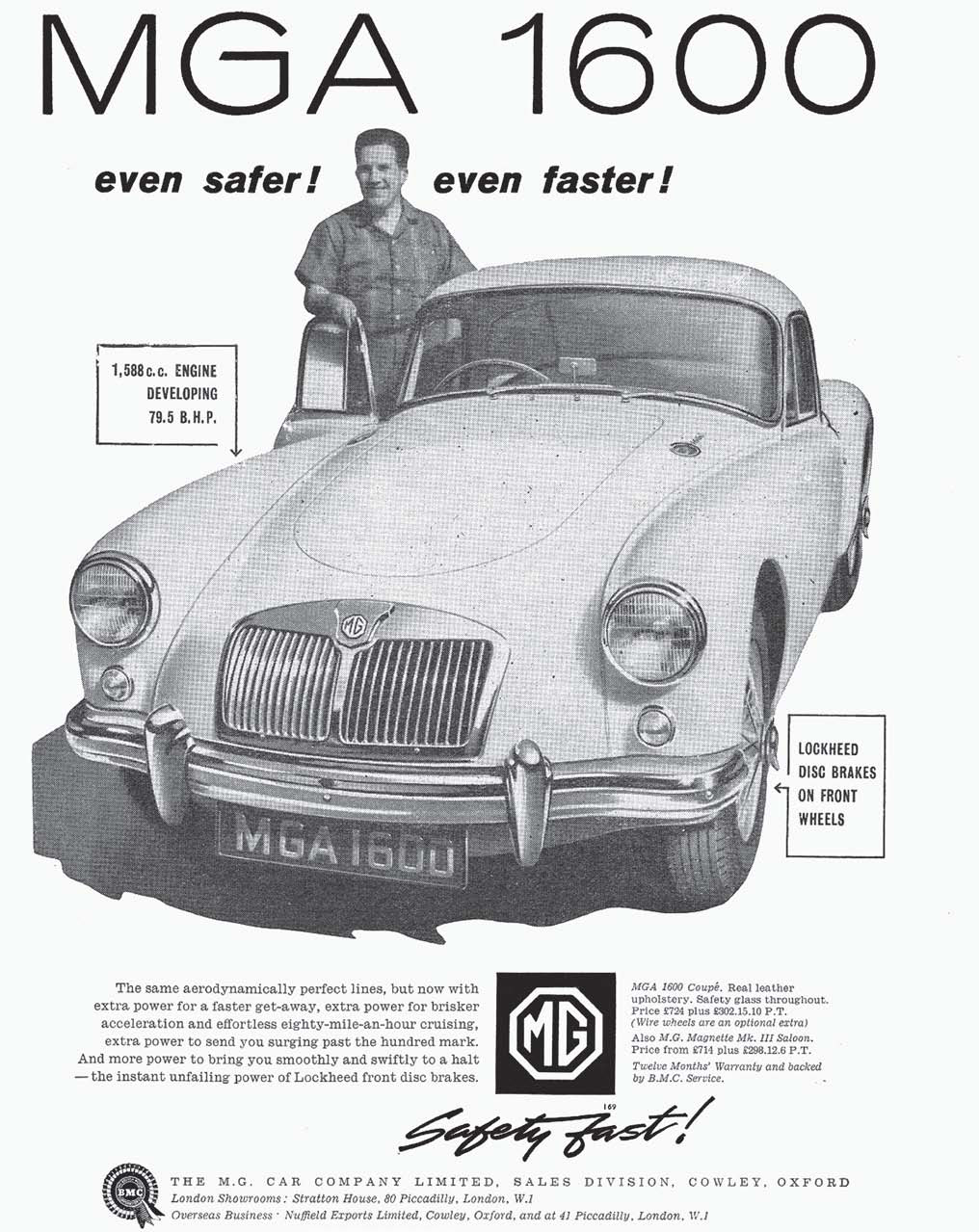
An advertisement for the MGA 1600 from a UK magazine, showing a Coupé
AUTHOR’S COLLECTION
A strap line used inside the brochure was the simple message ‘the sports car today – is an MGA 1600’, and a colourized image of the rear of a Roadster was accompanied by the observation that ‘This is the view of the “MGA 1600” that other motorists see most often – the sleek, streamlined, sculptured tail that frequently disappears out of sight as swiftly as the car comes into view.’ Also inside there was reference to the new features:
To the world-famous sporting performance of the MGA the more powerful 1600cc engine now adds more vitality, more crispness, more get-up-and-go. And the new MGA 1600 offers you even more than improved performance, safer braking: it also features such additional advances as new rear-light styling, new flasher lamps, new sliding sidescreens.
Home market adverts typically included the simple message ‘more power for the MGA’, and a paragraph listing features such as
…more driving power ... more braking power. Now ... more punch and more liveliness from a bigger capacity 1600cc engine. Power-packed for exhilarating performance. And increased safety from front-wheel disc brakes – smoothacting and instantly responsive. Other new developments include a re-styled hood with full vision wrap-around rear window and sliding side-screens. Separate amber flasher lights are now fitted fore and aft.
In the USA, BMC/Hambro as usual went their own way with advertising, and a few themes drew on the superior performance and disc-braked stopping power. One advertisement, for example, featured some flowery copy, typeset inside as though within a virtual octagon, with front, side and profile views of a whitewall-tyred MGA Roadster and a rhetorical question:
What is a true sports car? One born in competition – like the MG? Or one bred for the more tranquil joys of motoring just for the fun of it – like the MG? Two cars? No. One magnificent car. The new MGA 1600 – a safe, comfortable, go-anywhere kind of machine, submissive as a kitten, but cross-bred with tigers from the high-pressure lairs of racing.
It continued further in similar vein...
Another 1960 campaign featured the neat slogan ‘Poetry in Motion’, while a half-page advert used in California (shared between Gough Industries of Los Angeles and Kjell Qvale’s British Motor Cars of San Francisco) featured an MG logo with a lit fuse on top, a simple line-art sketch depicting the MGA, and the slogan ‘This little bomb – started the revolution’ alongside.
A colour advert used in some larger circulation magazines featured an MGA 1600 driving off to the right of the photo, its driver sporting the de rigeur flat cap and, the copywriter having again been given free rein, with the text:
Start of a perfect day – just set it in motion, throw out your cares, and fall in love with the road and all outdoors... because you drive the alert and responsive MGA 1600, it doesn’t drive you. This is the fastest, safest pleasure machine ever to wear the Octagon, the most prideful in looks and actions. A big-hearted engine, sure-footed road ability, obedient controls and fade-free disc brakes make driving an affair of the heart. A test drive will reveal why this is the best known symbol of what a sports car should be. Your BMC dealer can arrange a perfect day for it. Is it a date?
Another full-page colour advert featured a courting couple, their MGA clearly parked in a movie drive-in theatre with a film showing, the text this time being:
Best seats in the house... starring MGA 1600, the fastest, safest, smartest-looking sporting machine ever to wear the Octagon. Produced by BMC, the world’s largest and most experienced manufacturer of sports cars. Scenario and direction by you, according to your mood for fun or competition. Special effects: a real barnstorming engine, road-hugging suspension, precise steering, fade-free disc brakes ... and an award-winning performance every time you hit the road. Ask your BMC dealer for an audition. You’ll exit smiling.
In April 1961, a full-page advertisement appeared in the UK press with the slogan ‘Pace, Price, Pedigree’ and proclaiming that ‘…there’s nothing in motoring to equal the MGA 1600 for the young sports-car enthusiast. With good looks, a genuine 100mph [160km/h], Lockheed brakes on the front wheels, and the MG ‘Safety Fast’ features of firm road holding and stable cornering – what more could you ask?’ What more, indeed? Perhaps the all-round disc-brakes from the Twin Cam, or, in due course, an even better engine?
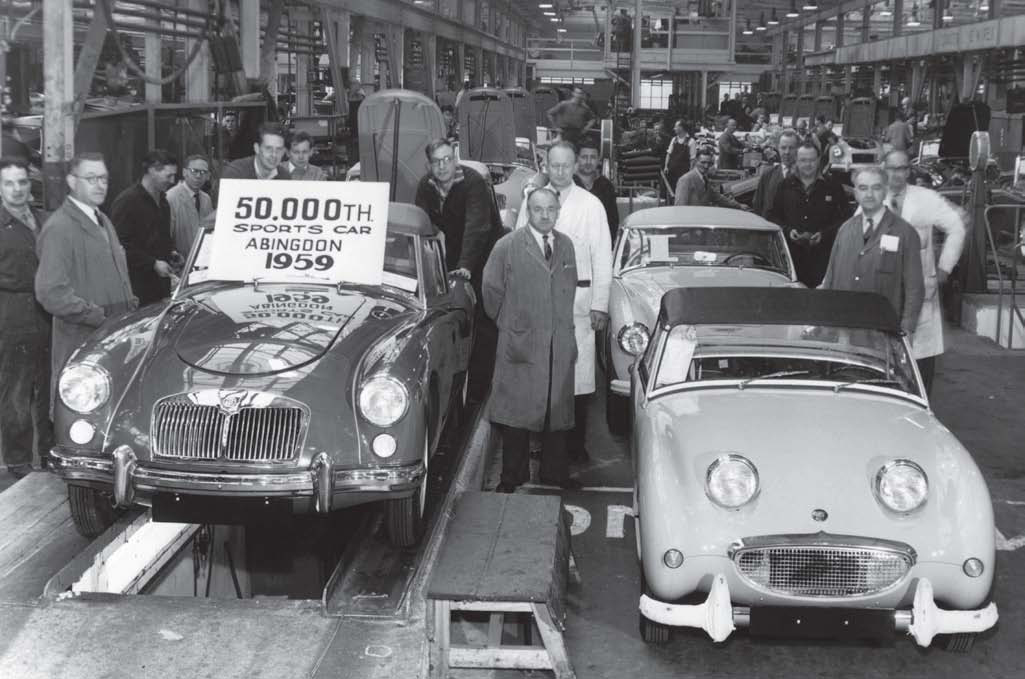
December 1959 marked a milestone, when the 50,000th sports car built in a year at Abingdon was celebrated. In a news item in the in-house magazine Nuffield Teamwork, where this photo appeared, it was noted that at the time ‘the rate of assembly is two cars every five minutes of the working day’, and that with Abingdon having 1,100 staff, ‘the production works out to one car per employee per week’. From the left are Phil Broad and Bill Singleton, and on the right, Ernie Boobier and behind him Jack Mathews, Jack Haywood and Fred Wake...
GRAHAM ROBSON; NAMES COURTESY ADRIAN GOODENOUGH
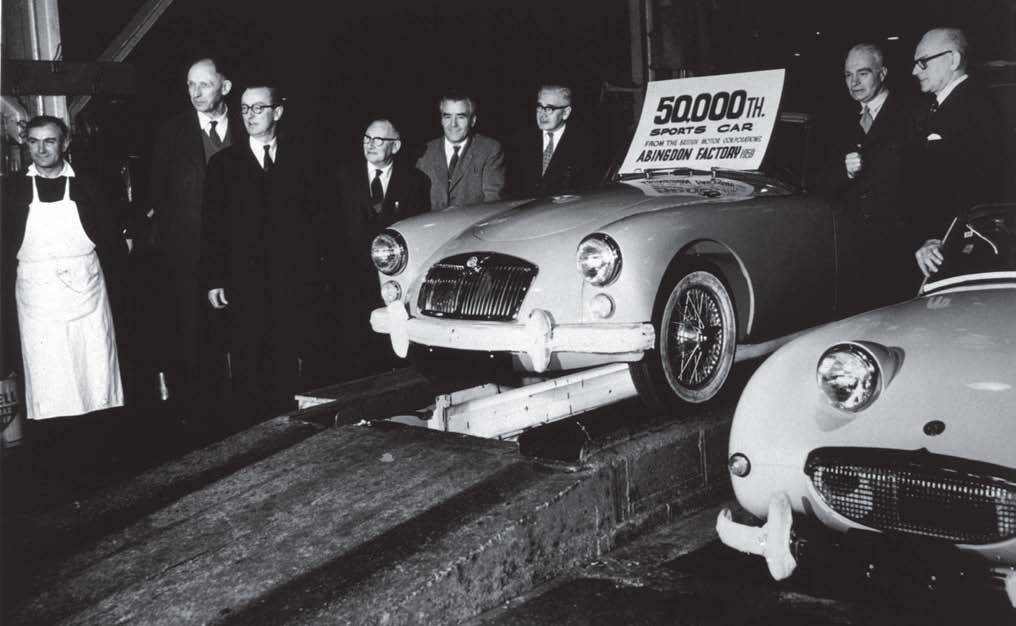
...but hang on a minute: isn’t that a different MGA in this photo using the same sign, with Cecil Cousins, John Thornley and Syd Enever (looking towards the camera)? Between Thornley and Enever is Charlie Martin (Chief Rate Fixer), and between Enever and the sign is Jack Lowndes (Chief Factory Engineer). On the right are George Morris (Rectificati on Supervisor) and finally ‘Ginger’ Wirdnam (Production Manager). One might understand the desire for different groups of people for each photo, but why around a different car? By the very end of 1959, Abingdon had built a total of 55,398 cars that year.
AUTHOR’S COLLECTION; NAMES COURTESY ADRIAN GOODENOUGH
Although 1959 proved a peak for MGA production, and indeed all Abingdon production to that point, in the ensuing period of April 1960 to February 1961 there was a second recession of relevance to the MGA (the first had been in 1958). As a consequence, in the autumn of 1960 there was a significant reduction in car sales, at a time when the US domestic car makers were also revising their attitude towards the inroads into their country that imported ‘compact’ cars were making, most of them from Europe. British sports-car sales – including those of MG, Austin-Healey, Jaguar, Sunbeam and Triumph – dipped dramatically, and the impact was typically felt at Abingdon and the various BMC plants that supplied the production lines there.

A lovely MGA Coupé 1600 with wire wheels and white-wall tyres appeared at the 1960 Paris Salon (6–16 October).
AUTHOR’S COLLECTION; PHOTO BY J. FONDINI
Contemporary reports indicated that MGA bodyshell production at Morris Bodies fell by as much as 60 per cent at this time, with up to 300 of the Coventry workforce directly affected, being reduced to a one-and-a-half-day week. One of the two lines of MGAs at Abingdon was temporarily turned over to Morris Minor van production, whilst one of the two Austin-Healey Sprite lines switched to building Morris Minor Travellers, both meeting a serendipitous increase in demand for such vehicles. Meanwhile the Austin-Healey 3000 line was still running, but at half its usual speed.
By the end of 1960, most of the Abingdon workforce was on a three-day week, and in January 1961 this fell even further, to two-and-a-half. However, in the spring the US market recovered as the recession came to an end, and meanwhile in BMC’s home market, the UK government relaxed hire purchase restrictions, which in turn helped rekindle demand and in turn output. By April 1961, fresh orders for sports cars from the United States meant that all but seventy of the 800 employees at Abingdon were back up to a full five-day week, and confidence was improving ahead of the coming launch of important new variants of the MG and Austin-Healey ranges and, in the not-too-distant future, the new MGB.
The decision to discontinue the Twin Cam (see Chapter 6) was not universally regretted across the BMC empire; its failure was mostly a disappointment to MG and Morris Engines (neither of whose reputations it had helped), as it had represented the noble concept of a semi-thoroughbred sportscar power plant of a kind that would surely have gladdened the heart of Cecil Kimber, had he still been around to have seen it. But with other changes on the way in BMC, not least important changes to the basic B-Series, which would be of relevance to the MGA Mark II and the subsequent MGB, Longbridge as well as the warranty departments affected across the organization would have been broadly relieved to see the Twin Cam go.

Mark Hester owns this car, the first MGA Deluxe, seen here at the MG Car Club annual ‘MG Live’ event in summer 2017.
To avoid duplication, this section embraces both the 1600 and 1600 Mark II so-called ‘Deluxes’, but readers are also directed to the later section in this chapter specifically on the Mark II for more on the changes that model brought, in particular to the engine, the lighting equipment, and some of the trim and safety-related items. The departure of the Twin Cam left in its wake the thorny problem of what to do with the many sets of special components that were either already in stock, or somewhere in the pipeline and subject to supplier commitments that still needed to be honoured.
The solution was to create a new, semi-official model variant, which became popularly known as the ‘Deluxe’ (although, as noted in the panel above, the term does not seem to have been used in publicity material), which would combine, broadly, the chassis of the out-going Twin Cam, complete with four-wheel disc brakes, centre-lock disc wheels and various trim and other specific items hitherto reserved for the Twin Cam, with the conventional overhead-valve B-Series engine, which had in any case been expanded to 1588cc, and would soon become the much modified 1622cc units seen in the Mark II MGA.
The decision to do this appears to have been made in the spring of 1960, by which time the end of the Twin Cam was already anticipated. The first MGA recognizable as a Deluxe was chassis number 91240, which started down the line at Abingdon on 28 April 1960. In the meantime, the last true series-production MGA Twin Cam (chassis number 2610 – 2611 was, of course, a one-off) had been built between 6 and 14 April, the last of eight to be completed in April 1960.
This first ‘MGA Deluxe’ (for want of a better name) did not reach completion until 9 June 1960; it was registered as VJB 112 on 12 May 1960, and identified as a UK specification demonstrator, being retained by the factory until it was sold off on 17 January 1961. Despite about a dozen changes of ownership it has thankfully survived, and since 2013 it has been owned by Mark Hester, who as of 2018 is in the process of restoring it to its former glory. Hester has undertaken an audit of some of the surviving Lucas electrical equipment, such as the ignition switch and wiper switch, and found that they had been manufactured in March 1960, not long before the car was assembled.
In the meantime, a ‘Confidential Service Memorandum’ MG/327 was issued on 30 August 1960, which confirmed that disc brakes (front and rear) and centre-lock wheels were being made available as optional extras, with the steering assembly, front suspension and rear axle modified to suit. Despite this, there has been little evidence of any factory sales literature beyond a reference in the sections that refer to options, despite a handful of dealer advertisements coming to light over the years.
A Driver’s Supplement (AKD1628 from May 1960) was entitled ‘Supplement to be used with the Driver’s Handbook AKD1172B when Road Speed tyres and disc brakes all rond [sic] are fitted as optional extras.’
The author is indebted to Graham Robson, who made a study of the MGA Deluxe when researching the subject for his excellent book The Mighty MGs, for the following production data, which shows a total of 395 overall, spread over a two-year period, more than 91 per cent of which were roadsters:
It is fair to say that two of those 395 are the 1961 Sebring cars, which were not coded in the records as ‘Deluxes’, and this would make the total 393. Either way, the addition of the totals of the MGA Deluxes and MGA Twin Cams therefore brings an overall total close to 2,500, which is likely to have been the agreed sanction originally determined for the MGA Twin Cam from the outset. The flurry of activity in the last three months of production, when 164 Deluxes were built (fully 42 per cent of the overall production number), shows how Abingdon was keen to ‘clear the decks’ in readiness for the new MGB.
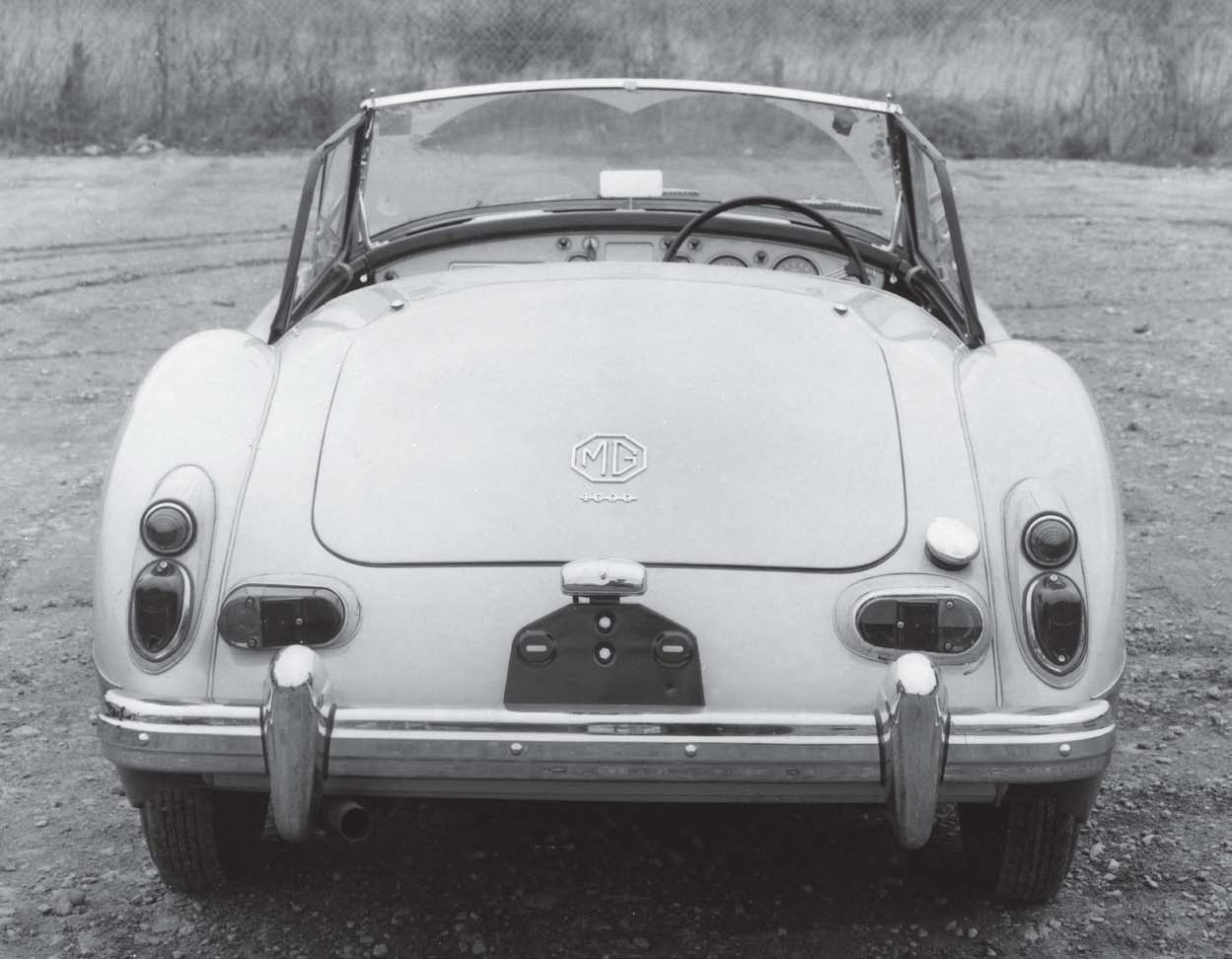
This MGA 1600 at Abingdon has, uniquely, an unusual combination of tail-lamps, with the prevailing MGA 1600 plinth as well as the Austin Seven/Morris Mini Minor units seen on the MGA 1600 Mark II.
© BRITISH MOTOR INDUSTRY HERITAGE TRUST
The last MGA Deluxe of all, a Mark II of course, was chassis number 108652, completed in June 1962, by which time Abingdon was well into the process of ramping up production of the MGB – which had neither a twin cam nor a four-wheel disc brake option. In North America there was reference in at least one publication (Sports Car Graphic) to a ‘Competition’ specification MGA, which appears to have been all but the same thing as an MGA 1600 Mark II Deluxe.
Detailed research into the story of the MGA Deluxe by the MG Car Club’s Twin Cam Group has shown that Deluxes have very easily identifiable body numbers. Early on, they continue on from the Twin Cam range until they reach body number ‘B1999/B2000’, then they follow another format. The author is indebted to John Barrett and Mark Hester for their diligent research into the following analysis:
During a series of visits to Gaydon in 2000 and 2001, John Barrett extracted by hand all the records relating to the Deluxes from the main MGA chassis records: he copied everything on all the Deluxes, noting that: ‘The Deluxe records were in crayon, not the fine tip pens we have today’ (the code used was blue for a Roadster, red for a Coupé, green for a Deluxe Roadster, and brown for a Deluxe Coupé). Barrett found that the use of crayon by the original record keepers meant that it was often very difficult to read the specifications: ‘There was too much information in too little space, written with a blunt crayon! To make matters worse, we didn’t initially know what all these letters meant. The factory did not completely standardize its abbreviations, either...’ See the table page 163.
WHAT’S IN A NAME: WHY ‘DELUXE’?
There has never been any doubt about the existence of a low-volume variant of the MGA 1600 (in both original and Mark II guises) designed to ‘use up’ surplus sets of components made available by the cancellation of the MGA Twin Cam. What has been the subject of much debate, however, is what these cars should properly be called.
MGCC MGA historian Edward Vandyk and his MGA archivist colleague Howard Quayle have studied the variant in detail, and for a start, Vandyk is adamant that from the naming point of view, there is no such thing as a ‘Mark I Deluxe’: ‘There is an MGA 1600 fitted with the optional Dunlop disc brakes all round and Dunlop Road Speed tyres. Indeed in period the name “Deluxe” was not used publicly by MG.’ Of course MG never referred to the original MGA 1600 as a ‘Mark I’ – the term only came to be used retrospectively by enthusiasts to define the model which preceded the ‘Mark II’, just as there were never such models as an Austin-Healey 3000 Mark I, or an MG Midget Mark I.
It seems that the lack of a formal name for this variant led to the use of the ‘De Luxe’ (or ‘Deluxe’) as a convenient short-hand term. The term (however spelt) had long been used as a means of indicating a more highly specified variation on any given theme, and MG’s parent BMC was no less guilty of applying the ‘Deluxe’ name to anything slightly special or better equipped. When this first came into use for the all-round disc brake MGA has long been a matter of conjecture: the author found reference to the use of the term ‘De-Luxe’ alongside ‘ADO 31’ in the Abingdon Sketch and Arrangement Drawing Numbers Register, where a sketch ‘SK 7242.R’, dated 8 April 1960, is described as covering ‘De-Luxe ADO31: Sketch showing holes in dashboard for Dash fittings’. Not having seen the sketch in question, the author is not able to comment any further on what those holes might have been for.

This Chariot Red MGA 1600 Coupé Mark II ‘Deluxe’, with chassis number GHD2-107231, was built at Abingdon between 23 and 26 February 1962.
VALLEY CARS

The Coupé Deluxe version of the MGA 1600 Mark II was quite a rare car – just twenty-three were built between June 1961 and June 1962; indeed from the table shown here, we can see that this particular car was one of just six built in the same month.
VALLEY CARS

This Chariot Red Coupé Mark II Deluxe has a neatly colour-coordinated red interior.
VALLEY CARS
Here, therefore, we have the use of ‘ADO 31’ (which is BMC code for the MGA 1600) and the use of the ‘Deluxe’ (strictly speaking ‘De-Luxe’) term in a factory document. It is worth noting that an earlier sketch in the series, ‘SK 7234.Z’ (dated 2 March 1960), relates to the adaptation of a Twin Cam body to take an MGA 1600 radiator – see Chapter 6 for the story of Twin Cams being converted in service – so clearly the crucial period when the MGA 1600 with all-round disc brakes came into being is around Easter of 1960. (The ‘R’ and ‘Z’ suffixes to these sketch numbers simply indicate the paper sheet size of the drawings involved).
Through their research, Vandyk and Quayle established an early external use of the term from the summer of 1960, but still not by the factory directly: ‘The name ‘Deluxe’ was leaked into essentially one advert placed by a dealer, Parade Motors, for one of these cars when they were offered for sale in July 1960 by University Motors, the London area main dealer as, what we would now call, a limited edition.’
Moving on a year and into the ‘Mark II’ period, South African MGA owner and enthusiast Brian Hogg shared with the author details of a Nuffield Exports letter from S. B. King, Nuffield Sales Technical Executive, dated 1 June 1961 (Ref SBK/Sales/Tech/No.5: ‘Confidential to all MG Distributors overseas – MGA 1600 Mark II Production Line Optional Extras’), which advised that the MGA 1600 Mark II was available ex-works with various options, including the Dunlop disc brakes all round, centre lock wheels and Road Speed tyres (all three together), along with other extras – but there was still no mention of any special name for these cars. (See also the side-bar on MGA 1600 Mark II optional extras later in this chapter.)
Somewhat after the event there was later reference to the ‘Deluxe’ variant in a brief retrospective in the MG Car Club magazine Safety Fast! in the July 1963 issue, which states:
When the Twin Cam ceased production in April 1960, the decision was taken to build an intermediate model to satisfy those who coveted the all-round disc brakes of that model, but not its rather temperamental engine. So some 1600s, known as the ‘1600 Deluxe’, were built with pushrod engines in the Twin Cam chassis, and a very pleasant car this little known model proved to be.
The author questioned Peter Neal, once part of the MG design team and more recently the MG Car Club’s archivist, who felt it likely that the Deluxe name possibly came into use through the use of ‘Deluxe seats’ in the cockpit, but agrees that the MGA 1600 with all-round disc brakes and centre-lock wheels was never formally known as an ‘MGA Deluxe’ at the factory, notwithstanding that sketch register entry.
Just to add slightly to the confusion, the BMC/Hambro importers seem to have toyed with an alternative name: at least one US magazine road test of an MGA 1600 Mark II fitted with the ‘Deluxe’ accoutrements (plus a hard top) was referred to in the publication (Sports Car Graphic – the May 1962 issue; the car supplied for testing in Los Angeles by Hollywood Sports Cars, at an allin listed price of $3,190) as a ‘MGA 1600 Mark II Competition’.
MGA 1600 ‘DELUXE’ – PRODUCTION VOLUMES FOR BOTH SERIES
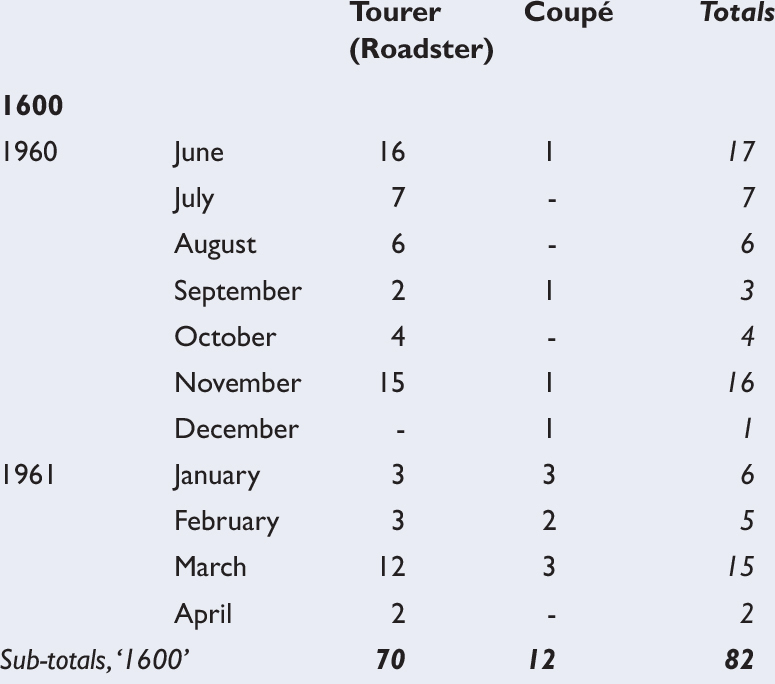

SOME NOTABLE MGA DELUXES
91240: The first car which might be identified as an ‘MGA Deluxe’, as noted in the main text; built between April and June 1960. Registration number VJB 112. MGA 1600 Deluxe Roadster in Chariot Red with red trim and beige hood.
The early cars essentially featured MGA Twin Cam bodies, complete with the removable panels in the wheel arches, although the heater shelf was different for all cars with the standard overhead-valve engines.
97290: MGA Deluxe Roadster exhibited at The Paris Salon in October 1960. Chariot Red with black trim and grey hood.
98734: The second works demonstrator, registration number WJB 405. MGA 1600 Deluxe Roadster in Chariot Red with red trim and beige hood.
102042: June 1961 – MGA 1600 Coupé Deluxe in Old English White with a number of factory extras for J.W. Keller, the Swiss MG agents and good friends of the Thornley family (Heinz Keller was the godfather of Peter Thornley and his son is Jürg Keller).
104428: October 1961, registration number YRX 986; MGA 1600 Coupé Deluxe used as reconnoitre car for the 1962 Monte Carlo and Tulip Rallies. Raced at Oulton Park in 1962 by Christabel Carlisle.
104429: Registration number 151 ABL. 1962 Monte Carlo and Tulip Rallies (see Chapter 10).
107473: 1962 New York Coliseum Show. MGA 1600 Deluxe Mark II. Old English White with red trim and grey hood.
108651: June 1962. The last MGA 1600 Deluxe Mark II to go down the assembly line.
108652: June 1962. The highest chassis number for an MGA 1600 Deluxe Mark II.
ACCESSORIES FITTED TO MGA ‘DELUXE’-TYPE CARS


Footnotes:
As this table shows, the record keepers at Abingdon varied their abbreviations slightly and so there is a likelihood of duplication where more than one code was used for broadly the same item. This information has been provided by MG Deluxe enthusiast John Barrett, to whom the author is grateful for his permission to reproduce it in this book; final confirmation of some elements only came in 2017 after some seventeen years of research.
MGA DE-LUXE BODY NUMBERING

By the time the next generation of MG sports car was on the horizon, the MGA was coasting towards retirement, but not without the honourable achievement of an unprecedented build total well in excess of six figures – a monumental feat for any sports car, let alone an MG built largely on the manual production lines at Abingdon. As we shall see in Chapter 9, attempts to update the MGA generally came to nothing, not only because of budgetary considerations but arguably because the basic material had been so right from the outset that any alterations would have been seen as unnecessary.
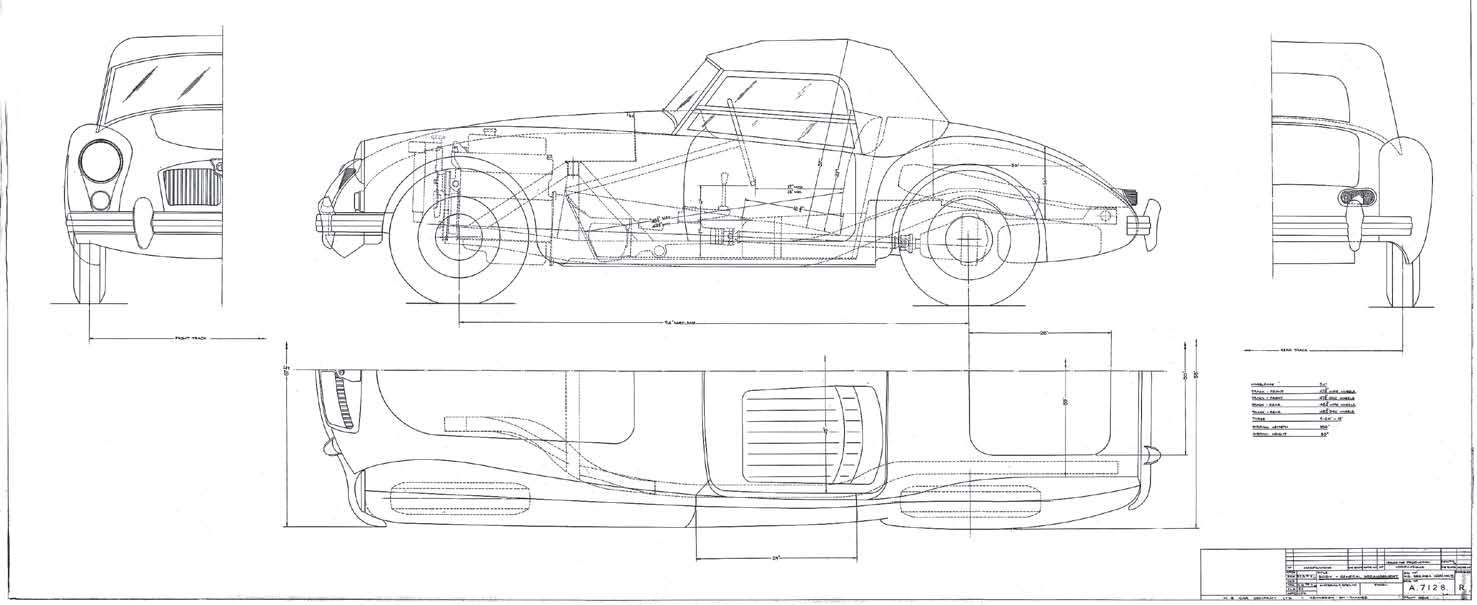
Blueprint for the MGA 1600 Mark II Roadster. The drawing number is A7128, dated 10 May 1961...
BOB VITRIKAS
Practical changes were driven by a combination of customer and distributor demand and legislative changes, especially to safety-related items such as lighting equipment. Furthermore development of some of the basic components by the parent company precipitated improvements or forced substations and specification alterations. An obvious change was under the bonnet, where evolution of the BMC B-Series engine led to the substation of the MGA 1600’s largely unique 1588cc overhead valve unit by a much-improved engine with a slightly larger 1622cc capacity (98.981cu in). The first MGA 1600 Mark II was chassis no. 100352 (the last of the superseded 1600 was 100351, with engine 16GA 31660).

The MGA 1600 Mark II was released on 7 June 1961, with a series of press photos featuring a female member of staff from Cowley.
AUTHOR’S COLLECTION
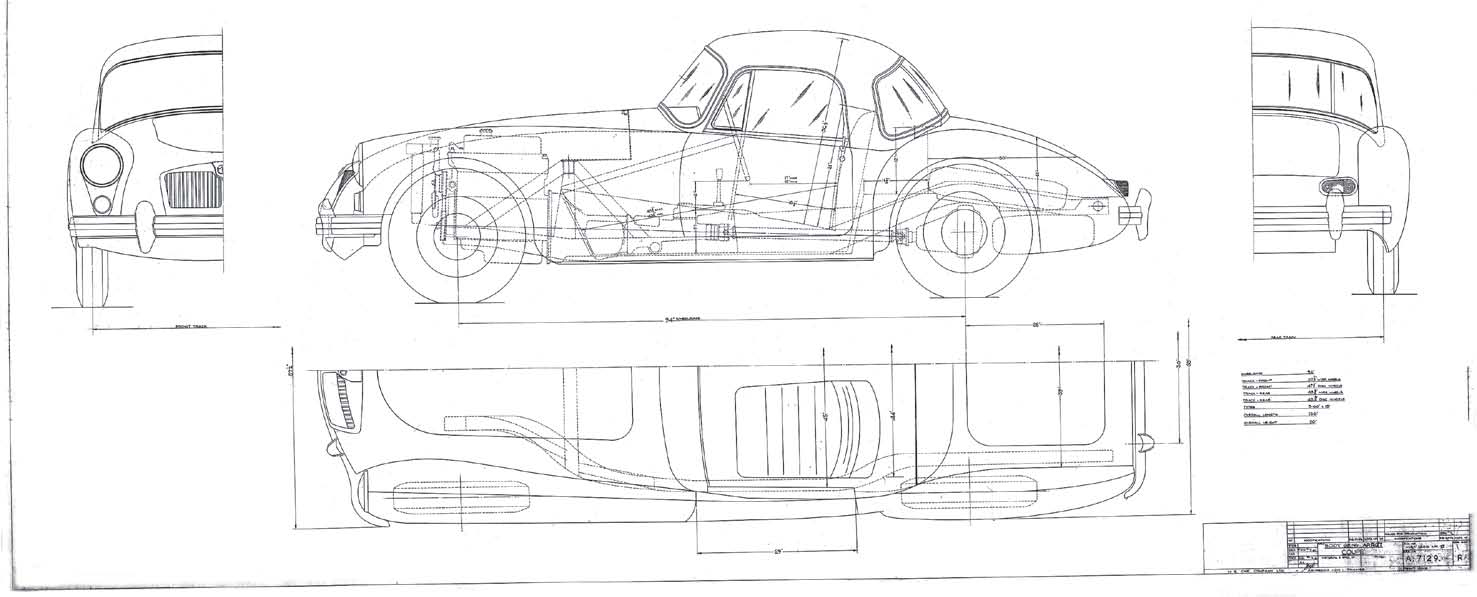
... and this is the equivalent blueprint for the MGA 1600 Mark II Coupé; this drawing is A7129, also dated 10 May 1961, like the Roadster drawing; there is an annotation ‘issued for production’ with Jim O’Neil’s initials.
BOB VITRIKAS

The most immediately obvious change on the MGA 1600 Mark II was the recessed grille bars – which divided opinion amongst MG fans as much as almost any change ever does.
AUTHOR’S COLLECTION
The bigger capacity for the facelift arrived by virtue of a modest but worthwhile increase in bore from 75.4mm to 76.2mm (from 2.97 to 3.00in, a difference of 1⁄32in), but this was just part of the story – the changes under the bonnet also extended to worthwhile improvements to the valve gear and combustion chambers, a modest increase in compression ratio (from 8.3 to 8.8:1 – although not in Australia) the net benefit being better power output (up 13 per cent to 90bhp for most markets; 84.6bhp in Australia) and this, coupled with a change to the standard rear-axle ratio (reduced from 4.3 to 4.1: 1), led to improved acceleration and maximum speeds in all gears.
Air-flow test rigs had been used to refine the profiles of the inlet and exhaust tracts, and higher compression ratio (where applied) was in part achieved by using flat-topped pistons in place of the previous slightly domed type. The engine was quite significantly altered in other more fundamental ways, with the block casting re-cored and the extent of the siamesing of the bores increased through the expedient of reducing the sizes of the water passages in the cast webs between the individual cylinder barrels. The crankshaft webs had also been beefed up, achieved through a slight reduction in the width of the main bearings (testing having shown there was capacity to safely permit this slightly counter-intuitive change), and there were stiffer con-rods and larger gudgeon pins. Other changes were the fitment of a new, slightly lighter flywheel and some strengthened gearbox casing webs.

From the rear, the other obvious exterior styling change was to the tail-lamps, which were in fact ADO 15 Mini units mounted horizontally on special plinths (the latter were painted at Abingdon).
AUTHOR’S COLLECTION
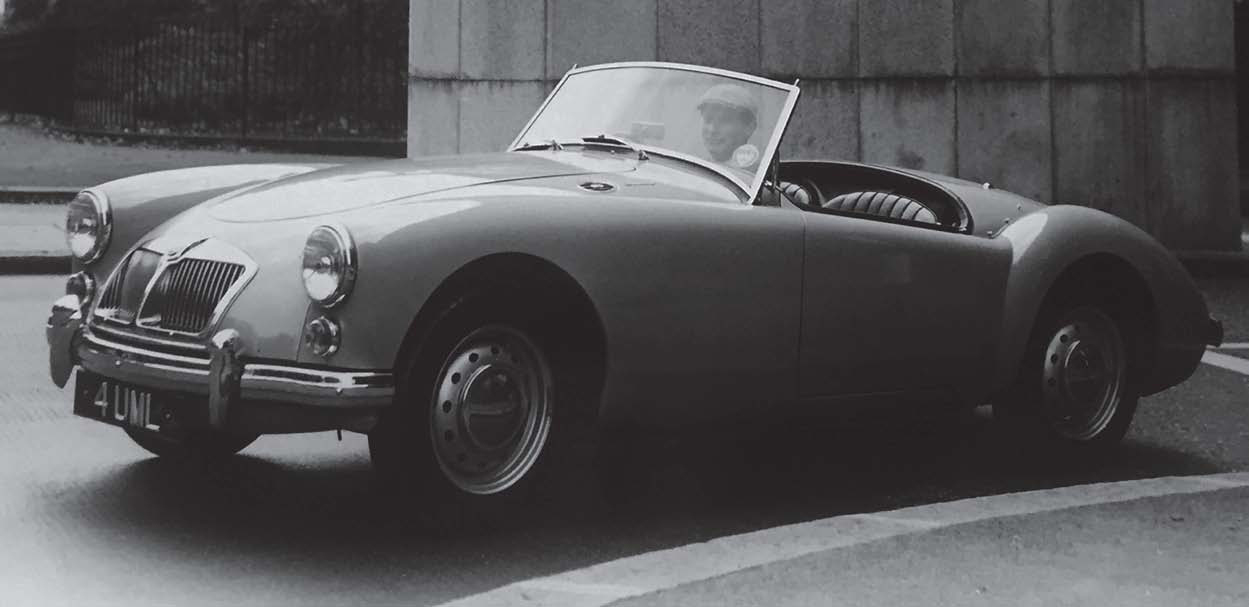
This press photo for the MGA 1600 Mark II was issued for the October 1961 Earls Court Motor Show, and is interesting for having a University Motors registration number, 4 UML. The statues symbolizing speed, seen on a plinth in the background, were erected in London’s Hyde Park, and were called ‘The Rush of Green’ or ‘The Bowater House Group’. The piece was created by famous sculptor Jacob Epstein (10 November 1880–19 August 1959), and had been unveiled earlier that year as one of the last pieces Epstein worked on before he died.
AUTHOR’S COLLECTION
Even if some motor-sports purists and die-hards might have frowned at a capacity increase that pushed the MGA into the 2-litre class, the significance of these changes (and a large part of the reason why the money was found to make them) was that they would apply to other BMC products using the B-Series engine. Whereas the MGA 1600’s 1588cc unit had been largely bespoke for MG, at a time when most BMC saloons had stayed with 1498cc, the new unit addressed demand across the whole range, and the 1622 would feature in many BMC saloons such as the Austin Cambridge (which moved from A55 to A60), Morris Oxford (Series V to Series VI), Riley (from 4/68 to 4/72) and Wolseley (15/60 to 16/60). Before long, the same basic unit would be stretched yet again to 1798cc for the BMC ADO 17 and the MGB, thereby directly handing on the baton between old and new MG sports cars.

Nearing the end of the line, but not quite at the final inspection, the fitter underneath this Old English White MGA 1600 Mark II, photographed in 1961, is one of the Carter brothers (the MG workforce included many families). From here, the car would move on towards the last station, where it would be filled with fuel and receive another inspection before moving to the test department for road test. In the background to the left can be seen the Austin-Healey Sprite Mark II/MG Midget line.
STUART SEAGER, NAMES COURTESY ADRIAN GOODENOUGH

The side profile of the MGA 1600 Mark II was basically the same as that of the preceding variants, other than the changes to the lights and grille, hardly visible from this angle.
BEAULIEU
Inside the cockpit, the most obvious change was that the facia (in most markets other than CKD ones) was covered with grained artificial ‘leather cloth’ with a non-reflective matt finish, by the name of ‘Nuvon’, rather than being left in body-colour paint, whilst externally the only really obvious changes were to the rear lamp clusters (which benefited from being up-to-date single units, compliant with new lighting regulations, even if they were an aesthetic compromise through being in effect BMC ADO 15 ‘Mini’ units mounted horizontally) and at the front, a modified radiator grille with inset bars set back from the front of the grille aperture (see photos page 171).
The latter move was initially looked at rather disdainfully by some purists, even if there were practical benefits in terms of reduced vulnerability to accident damage; however, time has provided a more balanced view of the change to the grille, and some MGA enthusiasts actually prefer the style of the Mark II. As a sign of the advances of vehicle safety, seatbelt attachments (located on the propshaft tunnel, but bolted through to the chassis frame) were fitted as standard, even though the idea of compulsory fitment of seatbelts would only come many years after the MGA had ceased production.
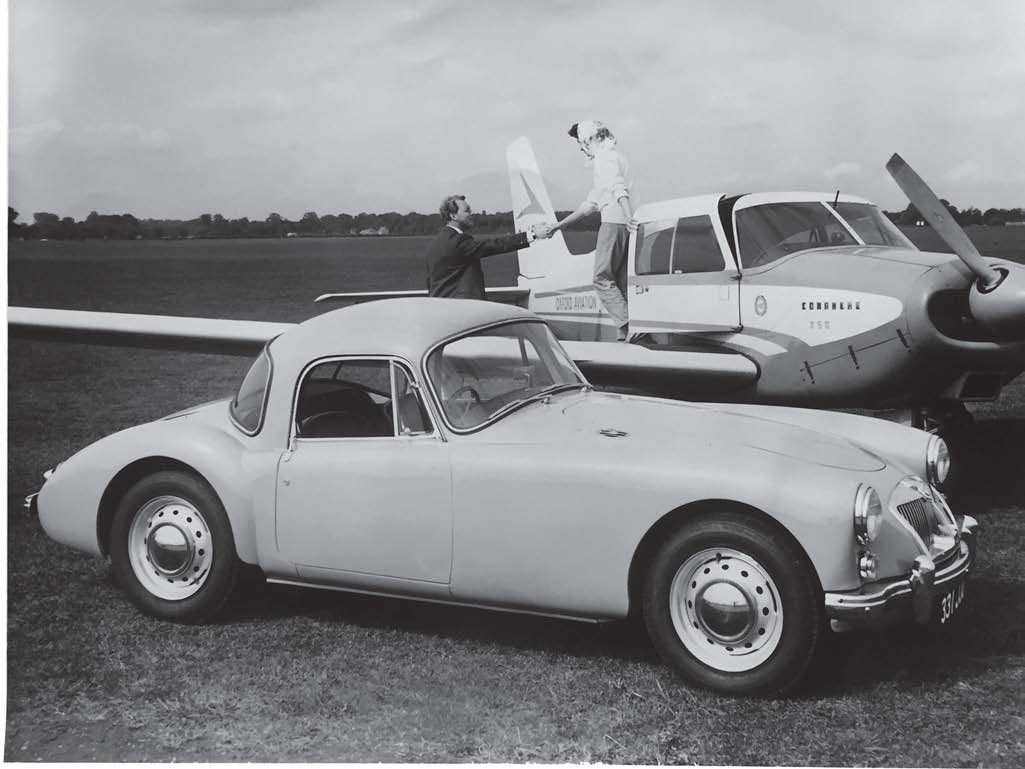
A press photo for the MGA 1600 Mark II Coupé, issued at the time of the October 1961 Earls Court Motor Show; a year after this, MG would be celebrating the new MGB, also using aircraft in some of the press photography.
AUTHOR’S COLLECTION
MGA 1600 MARK II – UK PRESS RELEASE
Printed on a label on the reverse of a set of four photographs released in the UK to announce the introduction of a new version of the MGA was the following text:
Confidential – not to be released before 28 June 1961: MGA 1600 Mk II
Powered by a new 1622cc ohv engine developing 90bhp at 5,000rpm, with a compression ratio of 8.4 to 1 and a 4.1 to 1 rear axle ratio, the MGA 1600 Mk II has increased performance with safety at high speeds yet retains the reputation of its predecessor for good road-holding and stability. Distinguishable by the redesigned and repositioned rear light clusters, the new radiator grille and the Mk II boot and scuttle motifs, the car has built-in anchorages for BMC safety belts. It sells in the UK at the same price as the MGA 1600, namely £940.7.6 inclusive of purchase tax.
Copyright free: Press Office, The Nuffield Organisation, Cowley, Oxford

Unlike the Hambro press photos of the earlier MGA 1600 (see earlier) BMC got it right with the MGA 1600 Mark II, with the correct plain hub-caps for the standard disc wheels. Inevitably centre-lock wires remained an almost de facto choice for many customers.
AUTHOR’S COLLECTION
MGA 1600 MARK II – OPTIONAL EXTRAS
The original Nuffield Organisation press release for the MGA 1600 Mark II was issued on 7 June 1961, with an embargo date of 28 June; the headline was ‘New look and better performance for the MGA’. Meanwhile, as touched upon earlier, a memorandum was issued by S. B. King of Nuffield Exports on 1 June 1961, setting out the factory options available for the MGA 1600 Mark II:

Original BMC accessory seatbelts are fitted to Adrian Malthouse’s MGA 1600 Mark II.
BEAULIEU
Production Line Optional Extras:With the introduction of the Mark II version of the MG ‘A’ 1600, distributors will no doubt wish to be reassured that the comprehensive list of optional extras offered on the MG ‘A’ 1600 will still be available. In the main this is so there are, however, a few minor alterations. The current list of production-line fitted optional extras is therefore as follows: Fresh Air Heater and Demister; Fresh Air Unit, Blower Assisted;Windscreen Washers;Wire Wheels; White Wall Tyres; Road Speed Tyres (5.90 × 15); Overall Tonneau Cover; HMV Radio; Alternative Axle Ratio – 4.55 to 1; Detachable Hard Top with de-luxe side-screens; Luggage Carrier; Dunlop Disc Brakes all round, including centre lock disc wheel and Road Speed Tyres (these three items are supplied together).
Items not covered by this list and which are offered by BMC Service Limited, can be obtained by Distributors direct from BMC Service Limited, by means of normal Parts stock orders. In addition the following Competition extras can be ordered for initial factory fitment: Close Ratio Gear Box;Anti Roll Bar; Oil Cooler; Competition Windshield; Competition de-luxe seats.
The author found that close scrutiny of the equivalent ‘home market’ and ‘export’ variants of the sales brochures (H.6120 dated May 1961, and E.6121 dated June) was also instructive; whilst an adjustable steering column was listed as an extra on the home market, evidently it was listed as standard on export cars. Ace Mercury wheel trims seem to have been offered only in the export brochure, which also listed an oil cooler as a supplier option.
Autocar briefly reported on the MGA 1600 Mark II in their issue of 30 June 1961, but subsequently subjected one (YJB 218) to their road-testing procedures, reporting on the outcome in the issue of 21 July 1961. The testers felt that the new version of the engine did not bring with it any significant improvement in refinement, but liked its sporting character and exhaust note. The magazine also thought that the 1622cc engine was a very flexible power unit, which pulled strongly from under 20mph (32km/h) in top. However, when pulling hard at low engine speeds, the common B-Series characteristic of occasional slight pinking was experienced when running on ordinary premium fuel, and ‘this did not disappear when super grades were tried’.
For performance testing, Autocar wisely used higher octane fuels to meet the MG factory’s recommendations in order to achieve maximum performance. However, whenever the engine was switched off, irrespective of the grade of fuel, the engine would run on ‘for a second or two, shaking violently on its flexible mountings’. This will be a not unfamiliar experience for many owners of cars with twin-carburettor B-Series engines, both MGAs and MGBs.
Meanwhile, however, the road-holding was adjudged to be of a high order, it being noted that:
All who drove the car agreed that it felt most stable when taken fast through a corner. A small amount of understeer is present, and the technique when cornering really hard is to use plenty of throttle to get the rear wheels to drift outwards a little. However, at no time at all did it show any unpredictable or awkward behaviour, and it must be judged a very safe car for the inexperienced and expert alike.
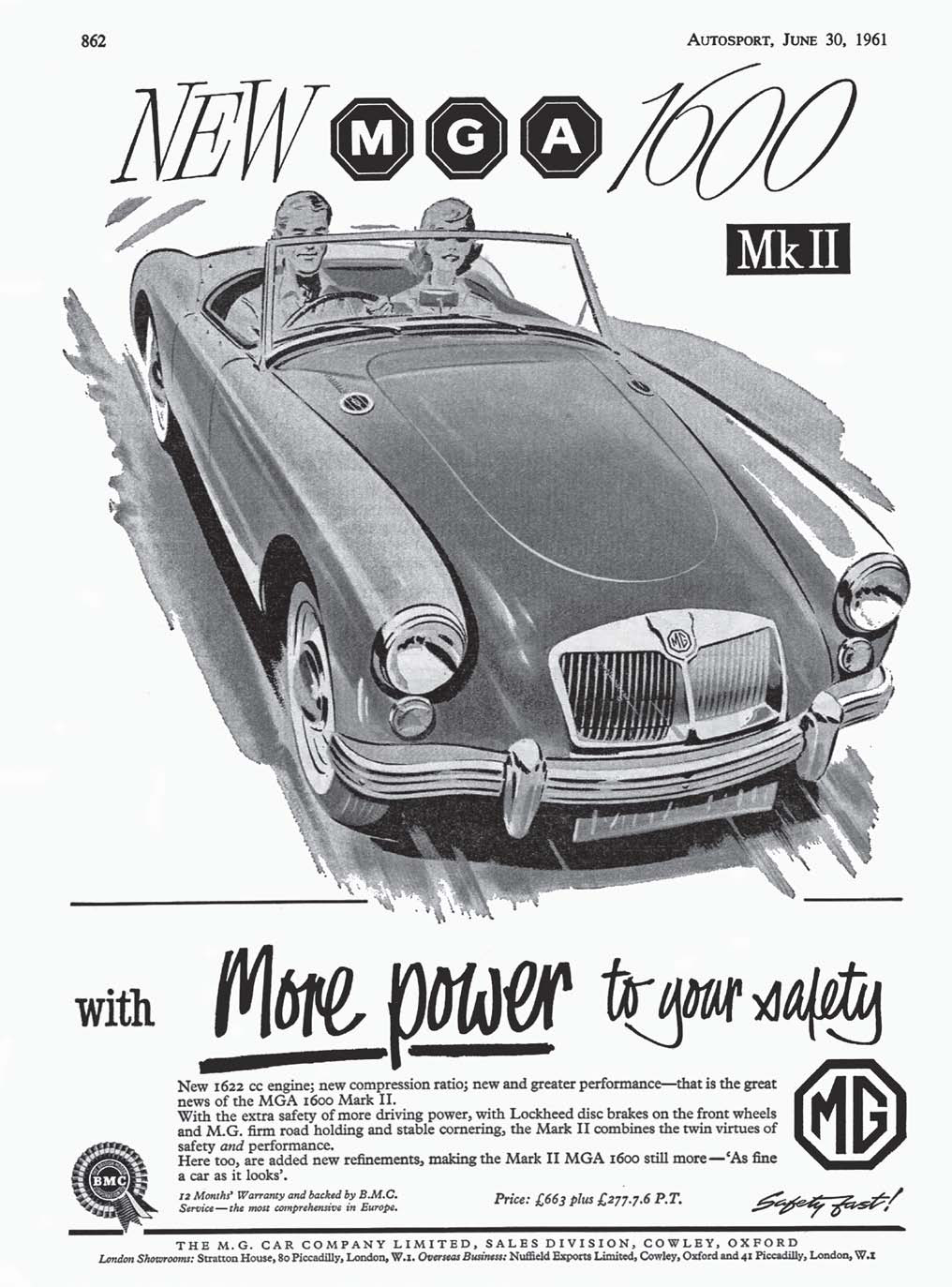
UK advertisements for the MGA 1600 Mark II proclaimed that the enlarged engine offered ‘more power for your safety’.
AUTHOR’S COLLECTION
Despite the emergence of sporting rivals with better hoods and such conveniences as wind-up windows, the testers were very generous in their assessment of the MGA’s hood and side-screens:
One person can erect the hood, although it is easier if there is assistance. An over-centre catch at the centre of the windscreen top rail prevents the hood from lifting in the middle. It was free from flapping at high speed, although wind roar was so great that conversation was impossible above 70mph [113km/h]. There were no signs of leaks during heavy rain, and the hood stows in a remarkably small space behind the seats. Metal-framed side screens housed in an envelope in front of the stowed hood cannot be considered ideal but give reasonable protection from draughts. The sliding plastic window in each screen soon became scratched.
Perhaps the forthcoming MGB refinements could not come soon enough.
In their closing paragraph, the testers concluded that:
In this latest MGA, which costs no more than the previous model, the engine modifications provide a little more performance, making this ample for most people’s requirements but, more important, this is achieved in a more effortless manner. Basically, the MGA’s traditional character, which has appealed to so many, is unchanged.
Road & Track tested the MGA 1600 Mark II for their September 1961 issue, sub-titling their report ‘Made in Abingdon on Thames by Water Sprites’. The test car came with just 4 miles (6.4km) on the clock, and so was not run in – it was handed over in person by Gus Ehrman (qv) who was in charge of BMC’s Los Angeles sales office. Notwithstanding a slightly ‘tight’ engine, Road & Track found that performance averaged out 5 per cent better than the MGA 1600 Mark I, which the magazine had tested for its October 1959 issue.


Jonathan Stein owned this MGA Coupé 1600 Mark II in the comparatively rare Dove Grey, nicely offset with a red leather interior.
JONATHAN STEIN

The interior of the MGA 1600 Mark II Coupé, a combination of red leather, red rexine and grey carpets.
JONATHAN STEIN
Top speed achieved was 105mph (169km/h), and 0–60mph took 12.8sec. Overall the testers formed an opinion that the Mark II was the best all-around sports car for the money, even if some of its virtues were at risk of being outclassed by younger opposition.
Less positively, the testers felt that the new engine was not as smooth as its predecessor:
In piling up miles on the Mark II, we got an impression that the engine isn’t quite as smooth or as quiet as before. Certainly a higher compression ratio often means rougher running, but we believe most of our impression was caused by a fairly loud exhaust note. The engine has no noticeable vibration period but, as with any four, there is a trace of rumble when decelerating. At low rpm the engine feels as though its being abused, yet it actually will lug in 4th gear at 1,000rpm, and full throttle gives smooth, reaction-free response.

Adrian Malthouse’s Iris Blue MGA 1600 Mark II strictly speaking belongs in Chapter 8 as well as this one, because it was originally exported to South Africa. It has chassis number GHN2/102909, and the dispatch date was 31 October 1961.

The 1622cc engine was a stepping stone to the 1798cc unit of the MGB.
BEAULIEU

Iris Blue is one of the colours that was effectively a bridge between the MGA and MGB

The distinctive 1600 Mk II scuttle badges alongside the elliptical grilles seen on all MGA variants.
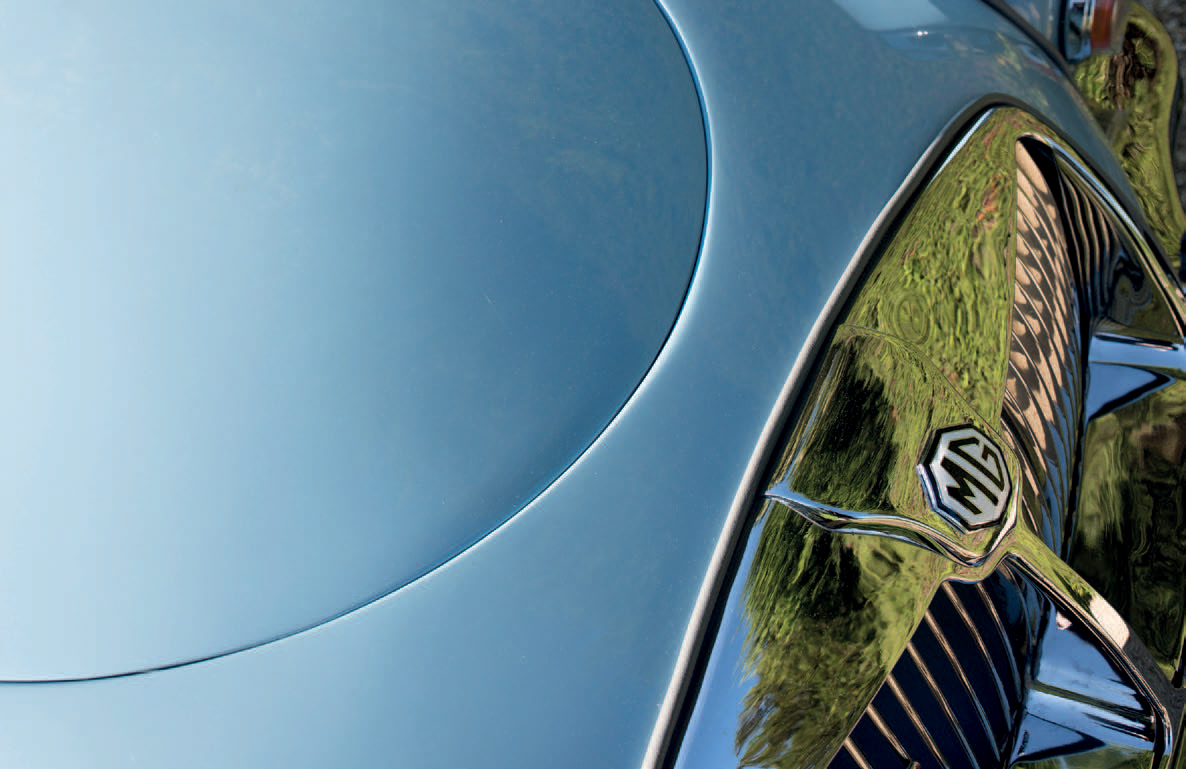
Notice the greater curvature of the bonnet on the later MGA body on the Mark II.
BEAULIEU

The MGA 1600 Mark II tail-lamps are one of the distinctive hallmarks of this model. Owner Adrian Malthouse imported it from its previous Johannesburg owner in March 2000, after which it was thoroughly restored.
BEAULIEU

The interior of the Malthouse Mark II is black; note the matching facia treatment.
BEAULIEU
These misgivings aside, the conclusion was that the MGA in its 1600 Mark II guise remained ‘truly the “universal” sports car’ Nevertheless, by 1960 it was pretty much an open secret that an all-new MG sports car was in the works, even if the form it might take was still a closely guarded secret....
Early in 1962, even as plans were inevitably advancing for the MGA’s imminent replacement, the remarkable production tally of the model was already apparent and clearly worthy of celebration. On 12 March the 100,000th MGA went down the production line, and the event was recorded for posterity by Stuart Seager, whose colour photographs appear here. The car itself, GHNL2-107989, was uniquely finished in metallic gold with cream leather interior trim.
The corresponding Nuffield Organisation press release was issued on 29 March 1962, the same day that the car set sail for New York on the Queen Mary ocean liner; the release proclaimed that: ‘It is particularly fitting that this historic car should be at the New York Show, as some 70,000 of the 100,000 MGAs so far made have been exported to the United States of America.’
At the factory, photos of the car show that its wire wheels were painted the same gold colour as the bodywork; however, by the time it had been shipped across the Atlantic and appeared in public again at the April 1962 New York International Motor Show, the painted wheels had been changed (not unwisely, surely) for rather better looking chromeplated ones. Alongside the gold car was a white MGA 1600 Mark II Deluxe Roadster (GHNL2-107473), which had also crossed the Atlantic in style aboard the Queen Mary.
For a number of years it was thought that the gold car had either been lost altogether or, as author Wilson McComb suggested, the importer had resprayed it a standard colour and sold it off – but thankfully the unique specimen had survived. It transpired that it had been acquired by Tennessee businessman Russell Skomp from a dealer in Nashville (John Tune Import Motors), who had it on show and appears to have sold it to Skomp almost by accident: when the salesman (presumably unaware of the car’s special status) shook hands with Skomp, the latter, determined to own it, resisted a subsequent appeal from the dealer principal to accept another car in lieu of the unique gold show car. In order to avoid a possible lawsuit, the dealer acquiesced and the gold MGA was handed over, its US tour prematurely abandoned.

The official Nuffield Organisation press release for the 100,000th MGA, issued on 29 March 1962.
ENEVER FAMILY

A rare production-line colour photograph taken by Stuart Seager of the unique gold 100,000th MGA, with its cream leather interior and – as built – gold-painted wheels. Watching from the left of the car, in his chargehand’s blue overcoat, is Bill Singleton. The surviving build card of this car records the body number as B39605, and there is a special note to the effect that during the build, ‘chassis [is] to go to paint shop before body is mounted’, which probably explains why Jack Privett from MG’s Finishing/Paint Shop can be seen here behind the wheel; clearly he had been tasked with the special care of this uniquely finished show car. Also seen behind the car is Sid Himpson.
STUART SEAGER, NAMES COURTESY ADRIAN GOODENOUGH
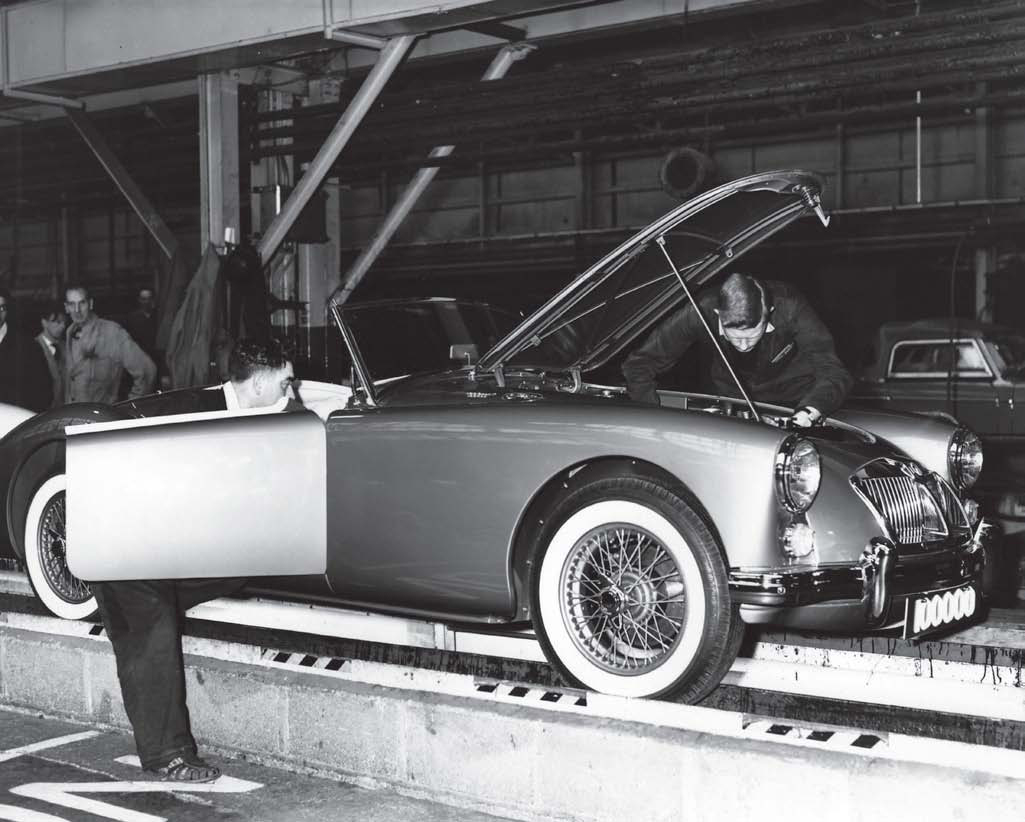
The specially finished 100,000th MGA on the line at Abingdon in March 1962.
G. ROBSON

Publicity photo of the 100,000th MGA.
ENEVER FAMILY

The 100,000th MGA poses alongside ‘Old Number One’ at the MG factory in Abingdon. Those gold-painted wire wheels would be replaced with glistening chromed ones for the car’s public appearance at the New York Motor Show in April 1962.
AUTHOR’S COLLECTION

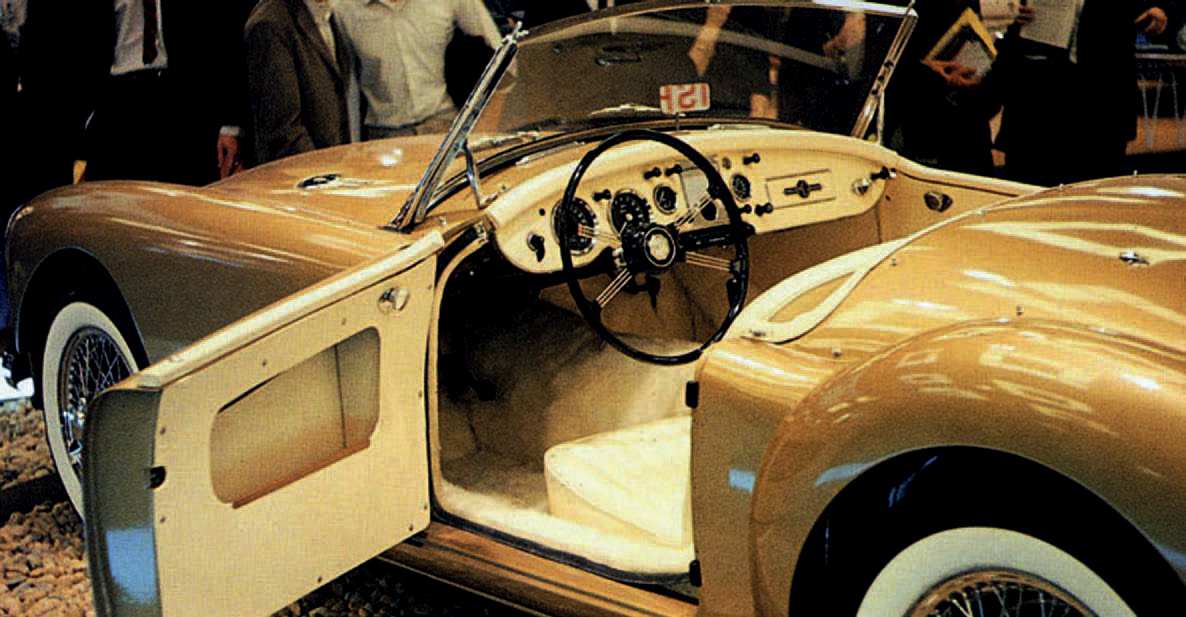
The gold MGA with its special white interior had pride of place on the MG stand at the New York Motor Show. Note how, whilst the special paint, trim and whitewall tyres had survived the trip from Abingdon, the gold-painted wire wheels had been ditched in favour of plated ones. The interior also featured sheepskin carpets.
AUTHOR’S COLLECTION

BMC proudly proclaimed the 100,000th production milestone in magazine advertising.
AUTHOR’S COLLECTION
When Russell Skomp took over the gold MGA, he used it for a short time until it was incapacitated by some minor fuel system malady, at which point Skomp simply parked it outside on his forty-acre ranch near Springfield, Tennessee, with just 8,000 miles on the odometer, and left it there. The special MGA sat in a field, largely untouched, for the best part of four decades until Russell Skomp passed away in 2000.
Soon after this, Russell Skomp’s younger brother Fred acquired it, and so began a painstaking restoration.
In the end, Muncie Import Auto stepped in; they had successfully completed all the special interior work on the car and they agreed to help fix all the outstanding problems. Fred Skomp and his wife Cindy ended up with a superb, unique MGA, which they were both able to enjoy for a while. Now it sits in Moss Motors Museum in Petersburg Virginia – and even now has only 11,000 miles (17,700km) on it.

The beautifully restored 100,000th MGA on display in the MOSS USA showroom.
MOSS
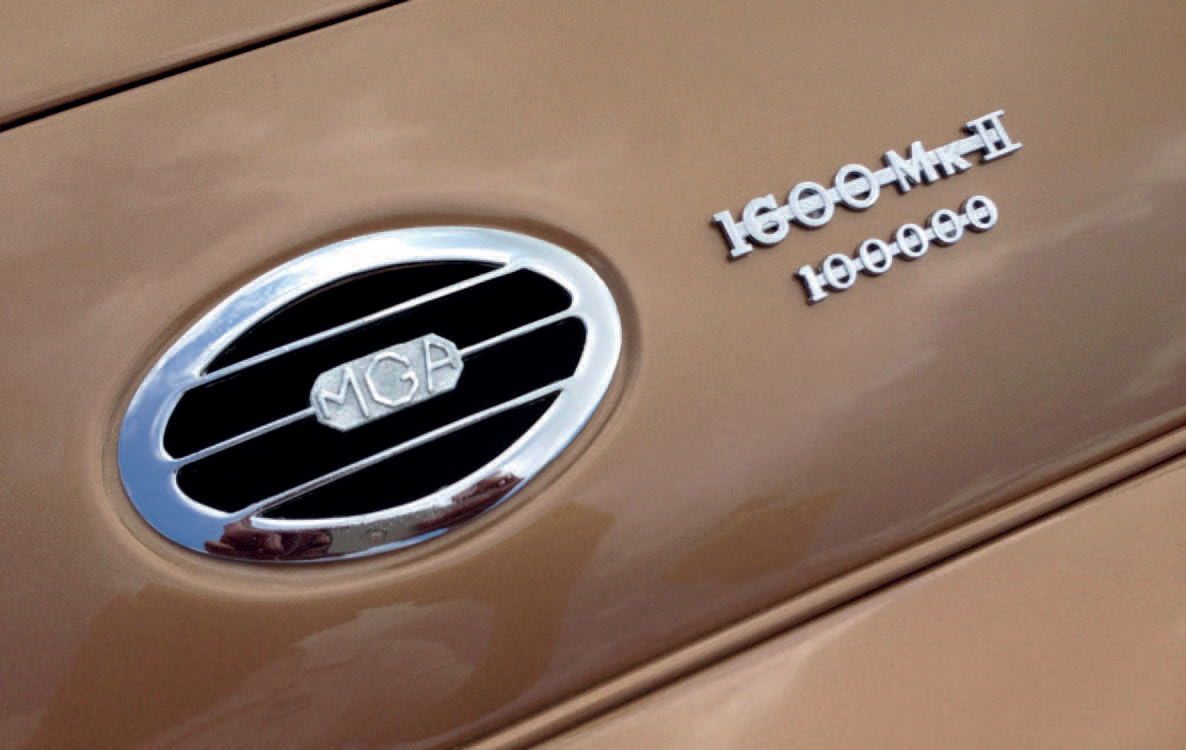
A special 100,000 badge was fitted on the cowl just beneath the normal 1600 Mk II badge.
MOSS
Marketing of the new model in the UK played on the traditional ‘Safety Fast!’ slogan by declaring that the new MGA 1600 Mark II offered ‘More Power to your Safety’, a strapline seen not only in the home-market press release material, but also in the corresponding twelve-page fold-out home-market brochure H.6120 (with an equivalent numbered E.6121 for export) and contemporary magazine advertisements. Inevitably versions of the same basic literature appeared in various European markets; for example, the German MGA 1600 Mark II brochure proclaimed ‘Mehr leistung... zu Ihrer Sicherheit’ which, obviously modelled on the UK slogan, simply means ‘More power ... for your safety’. Clever UK marketing literature, aimed solely at distributors and dealers, made reference to ‘More power to MGA 1600 sales’.
Meanwhile BMC/Hambro also issued a press release for the benefit of dealers and distributors to assist them with their own media advertising. Issued with a single threequarter view of the new model, the BMC/Hambro text declared:
The world’s most famous family of sports cars has a new heir – the MGA 1600 Mark II. This 1962 version MG has a more powerful 1622cc engine capable of 90 brake horsepower – an increase of nearly 12 per cent over its forerunner, the MGA 1600. This added power is due to larger inlet and exhaust valves, a higher compression ratio of 9:1, and increasing the rear axle ratio to 4.1:1. The new Mark II MG will hit top speeds of over 100 miles an hour [160km/h] and will deliver from 25 to 30 miles per gallon [11 to 9.4ltr/100km]. Seatbelt anchorages are standard equipment on the Mark II. The classic styling of the MGA 1600 is virtually unchanged on this new model. An improved tail-light placement, setting the grille back to prevent parking dents, and more extensive use of leather upholstery in the cockpit are the only changes.

BMC/Hambro issued this photo of an MGA 1600 Mark II with their press release for the new model.
AUTHOR’S COLLECTION

Simple two-sided black and white brochures – more accurately leaflets – were popular at BMC/Hambro in the period 1960–66; this is the front face of the MGA Mark II leaflet issued in July 1961.
AUTHOR’S COLLECTION
For their magazine advertising in the USA, BMC/Hambro resorted to different tactics, for example, in one nationally run advertisement calling the Mark II ‘the get-away car’; the copy included the exhortation:
Back seat drivers, g’bye! This one is deliberately designed for a carefree twosome to slip into snug bucket seats, take the helm, give it the gun, flash through teeming traffic, and head for their favourite wide open spaces. Alone. This is the sports car for a guy and a gal who dare to get away with an MG, knowing that everyone’s watching them. Enviously.
The last MGA 1600 Mark II Coupé was chassis no. 107031, but the Roadster finished at 109070: it was registered 326 ELO, built 14 to 19 May 1962, finished in Iris Blue, and with engine number 16GC 8851; it left the production line on 7 June 1962, marking a total of 101,081 MGAs built. By this stage the MGB was already entering early production: the first MGB, GHN3-102, a left-hand-drive car, was built on 22 May 1962 and finished, like the last MGA, in Iris Blue. There was little ceremony at BMC as the MGA came to the end of the line, as corporate focus had already shifted to this new model, with many creature comforts that the MGA lacked – such as wind-up door windows – and a larger (1798cc) engine. The Syd Enever MGA Coupé KMO 326 (see Chapter 5) was rather cheekily given chassis number 109071 after the event.
John Thornley, Syd Enever and their talented Abingdon team could be justly proud of the first production aerodynamic MG sports car; 101,081 cars had been built in a seven-year span, an unprecedented total for such a model, which had truly been a revolutionary MG, with 94 per cent exported in its seven-year production run. Surely none of them could have predicted the success of the car that followed in its wake: but that truly is a story for another book…
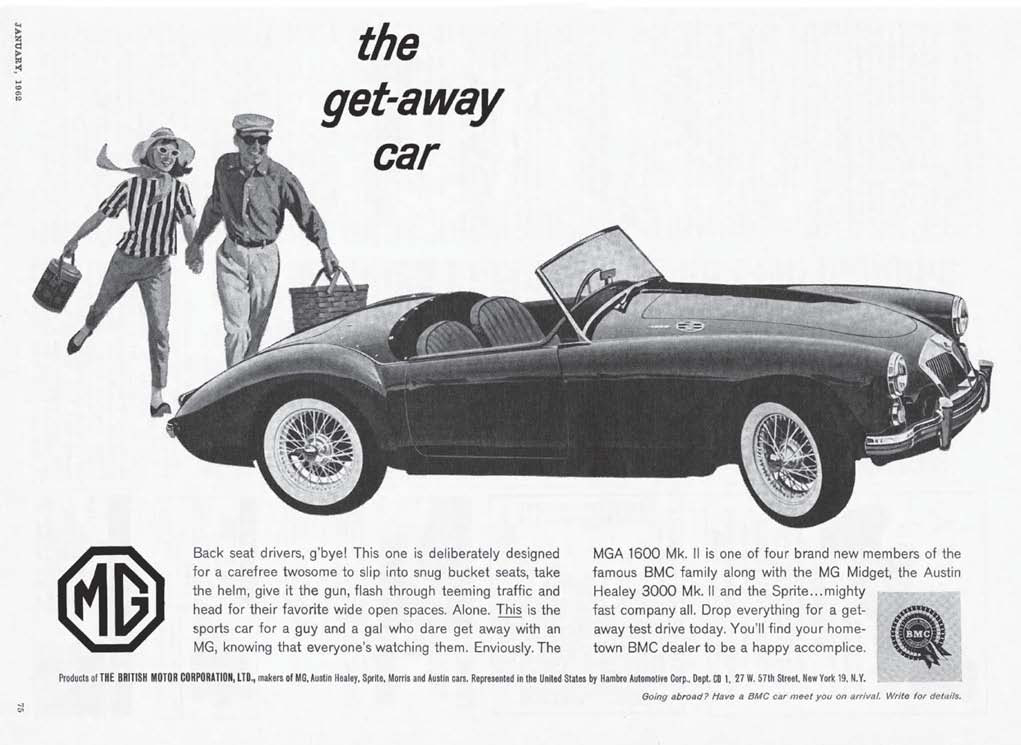
A Hambro advert for the MGA 1600 Mark II: ‘Back seat drivers, g’bye! This one is deliberately designed for a carefree twosome to slip into snug bucket seats, take the helm, give it the gun, flash through teeming traffic and head for their favourite open spaces.’
AUTHOR’S COLLECTION

It is sometimes obvious that a product is nearing the end of its life when the marketing gimmicks become ever more preposterous. In the spring of 1962, the US arm of Beecham’s popular ‘Brylcreem’ hair cream ran a competition with prizes of fifteen MGAs for the best answers to the question ‘I feel like a tiger when I use Brycreem because...’ and the author of the very best answer would also be given a real life Bengal tiger (or, if the winner was too nervous of being eaten or mauled to death, a substitute prize of $500). Imagine the understandable outcry were the idea of such a competition prize contemplated nowadays!
AUTHOR’S COLLECTION

This is the last MGA chassis to be welded up at Abingdon, truly marking the end of an era as the MGB would be of chassis-less monocoque construction. Left to right are Fred Baxter, Len Carter (foreman), John Herring and Dick Stevens (chargehand).
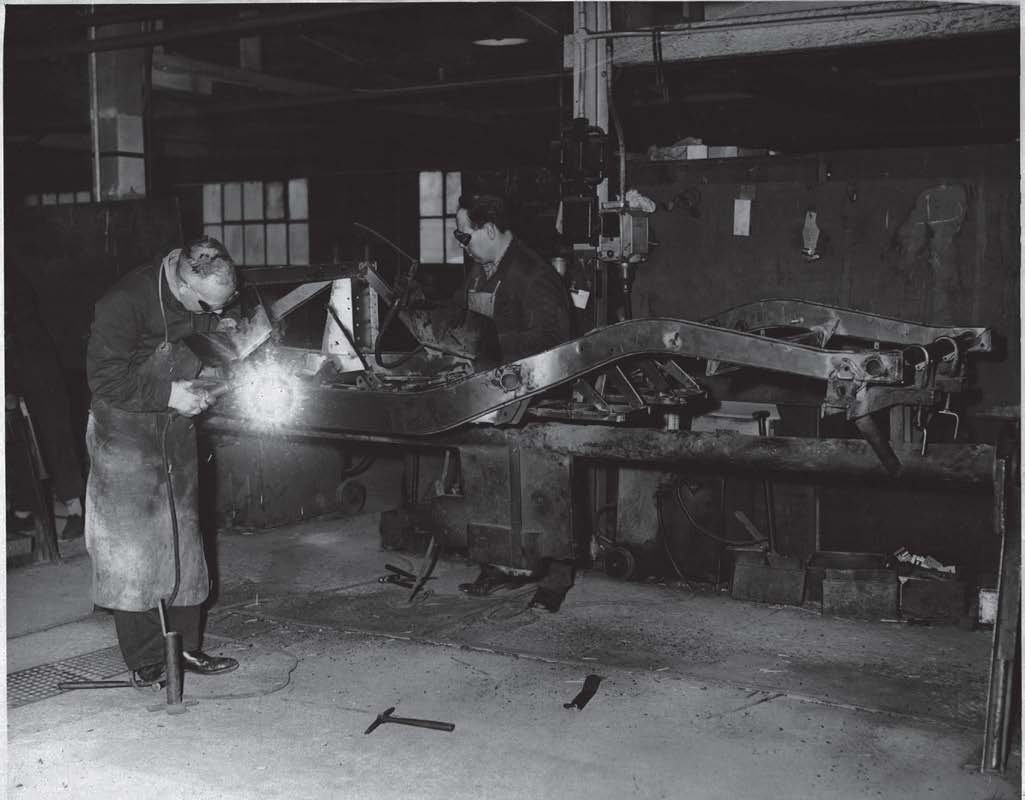
Sparks fly from the final MGA chassis at Abingdon in 1962.
Elvis Presley so loved the MGA 1600 that he used when filming Blue Hawaii in 1960 that he acquired the car, and it remains part of the family collection to this day.
AUTHOR’S COLLECTION

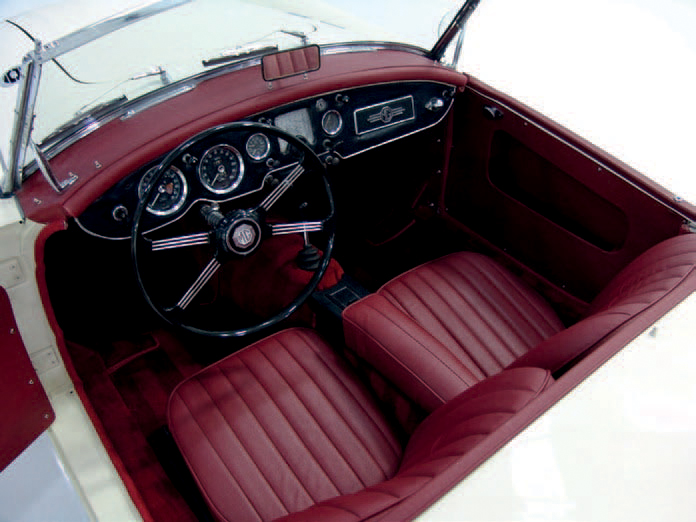
Robert Redford is believed to have owned this Old English White MGA 1600 Mark II with red trim, having purchased it new in 1962.
DANIEL SCHMITT

Tommy Steele was in his heyday in 1959 when he starred in the now largely forgotten J. Arthur Rank Film Tommy the Toreador, which also featured Janet Munro, Sid James, Bernard Cribbins, Noell Purcell and Kenneth Williams – more familiar as stars of the ‘Carry On’ film franchise. The MGA appears to be incidental, in this publicity still, issued by the film promoters.
AUTHOR’S COLLECTION
MG MGA 1600 COUPÉ, MG MGA TWIN CAM COUPÉ (CAR 2292 ON) AND MG MGA 1600 MK II COUPÉ
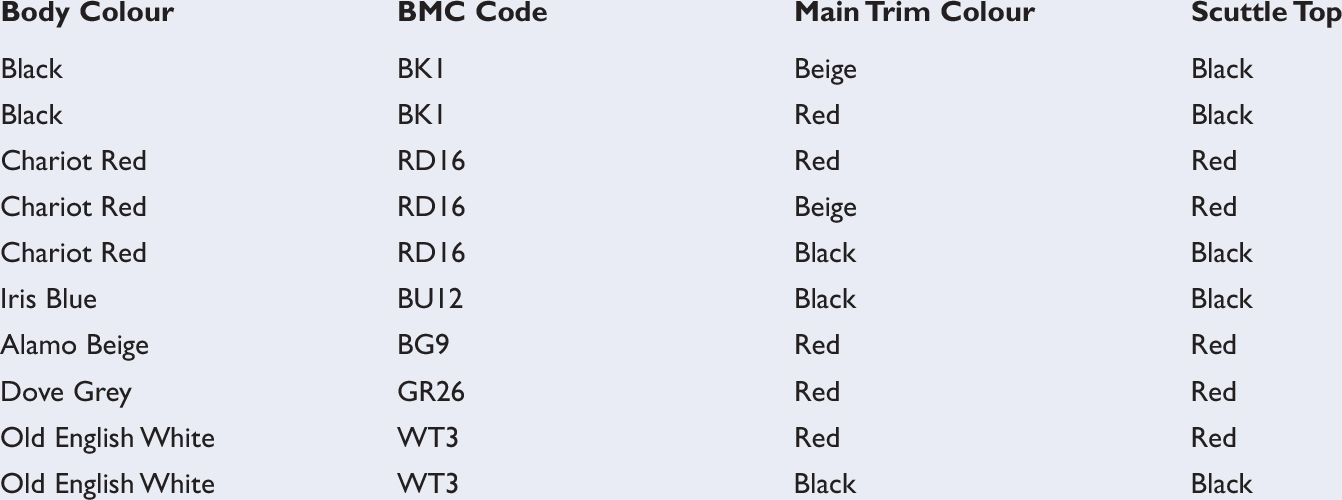

Footnotes:
As with the earlier MGA 1500, production of the first series of MGA 1600 was dominated by export sales, with 80% going to North America. Figures for the Mark II are set out in a separate table alongside. For more about ‘CKD’ production, see Chapter Eight.
MG MGA 1600 MARK II PRODUCTION TOTALS

Footnotes:
These figures show the continuing dominance of roadster output and exports to North America as percentages of the total volumes, accounting for overall 94 per cent and 74.2 per cent respectively. Just 521 MGA 1600 Mark II Coupés were built, of which just 182 were destined for North America. It can also be seen that total CKD output as a percentage was down to 2.57 per cent of the grand total of 8,719 (see also Chapter 8).
MGA 1600 CHASSIS AND ENGINE NUMBERS
MGA 1600 CHASSIS NUMBERS
The chassis number details for the MGA 1600 record less detail than the earlier 1500. The codes are as follows:
1st digit: ‘G’ = MG
2nd digit: ‘H’ indicates a capacity range of 1400–1999cc
3rd digit: ‘N’ indicates an open two-seater Roadster; ‘D’ indicates a Coupé
4th digit (where used): ‘2’ = MGA 1600 Mark II
4th or 5th digit (where used): ‘L’ = LHD
Numbers: MGA 1600 – 68851 to 100351; MGA 1600 Mark II – 100352 to 109070
MGA 1600 ENGINE NUMBERS
The first MGA 1600, with the 1588cc engine, had ‘16GA-U-H’ prefix codes. The significance of these characters is ‘16’ for 1588 cc; ‘G’ = MG; ‘A’ = a so-called ‘Type’ letter; ‘U’ = central gear-change (as opposed to a column change) and ‘H’ = high compression ratio (the engine prefixes were often just ‘16GA-U’, as all had the same 8.3:1 compression ratio). For the Mark II, with the substantially revised 1622cc engine, the engine prefixes were ‘16GC-U-H’ (compression ratio 8.8: 1) or ‘16GC-U-L’ (8.3: 1), where the ‘C’ is a new ‘Type’ letter, and the ‘H’ or ‘L’ indicates high or low compression ratio respectively.